S.W. O'Connell's Blog, page 9
April 28, 2019
A Loyal Hillbilly
It has been some time since the Yankee Doodle Spies featured the Loyalists – those very proper Americans who stayed loyal to the King and Britain during the time of political upheaval and blood war. As a rule, these were conservative and very proper folk. But they did have their share of bad asses. One of these was a notorious and stubborn orphan from the back woods of the Carolinas.
Life in the back Hills
David Fanning was born in Birch Swamp, Amelia County, Virginia in 1755. In July 1764 Fanning was orphaned. As a result the young David was bound to Needham Bryan (Bryant), a county justice in Johnson County, North Carolina. The justice provided for his education but was by Fanning’s account, harsh. Or maybe young David was a bit of handful. So in 1773, when Fanning was 18 and of legal age, he left his guardian and moved to Raeburn’s Creek in the western section of South Carolina. There the young man farmed and traded with the nearby Cherokee Indians. Although life on the frontier was not easy, it was reasonably good for for the enterprising young David Fanning.
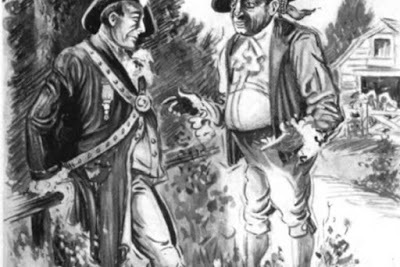 Fanning in the back country
Fanning in the back country
Things began to change when the American Revolution broke out in 1775. At the time, Fanning was a company sergeant in the Upper Saluda militia of South Carolina. Most up country Carolinians were sympathetic to the crown and eyed the lowland planters and merchants with suspicion. There was friction. A delegation from the low lands established a tenuous truce that was broken when a local Loyalist was arrested in November. Soon rumors spread that the rebels were enticing the Indians to their side. That was it. Accosted and robbed by patriot militias, Fanning sided with the local Loyalist faction.
Fighting for the King
David Fanning served under Major Joseph Robinson in military operations in western South Carolina. He was part of the force that captured a large Patriot garrison at the key Fort Ninety Six in November 1775. But Fanning himself was nearly captured in December that year during the battle at Big Cane Break. Eluding the local patriots, Fanning fled to the Cherokee Indians.
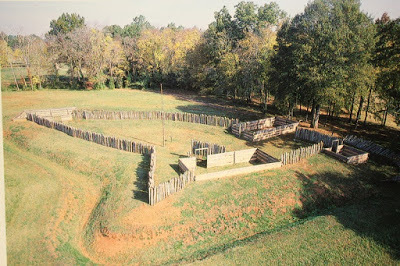 The Fort at Ninety Six
The Fort at Ninety Six
Now wanted as a notorious Loyalist, Fanning was taken prisoner by the rebels in January 1776. This was the first of what be a possible record 14 times during the war! In some of these he was paroled but the cunning and relentless Fanning made numerous harrowing escapes. Between these periods of imprisonment Fanning proved a ruthless, enterprising and aggressive Loyalist officer. He relentlessly led partisan units in almost nonstop skirmishes with the rebel forces in the area. He was a key figure in the little known but decisive back woods civil war that would eventually turn the Carolinians against their British masters and those Loyalist supporters of the crown.
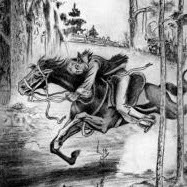 David Fanning made numerous escapes
David Fanning made numerous escapes
The Loyalists take a Knee
But by August 1779, most of the Loyalists were losing heart. They had suffered heavy losses and it looked like the south would be lost to the crown. Many of them, including Fanning, agreed to a conditional pardon by Governor John Rutledge. This kept Fanning out of the fray for several months. Fanning’s numerous escapades had taken a toll on him. By his own admission he was worn out, frazzled and skeletal in appearance. His many wounds and injuries had taken their toll. Fanning had even agreed to guide patriot militia units in the back country as part of his pardon.
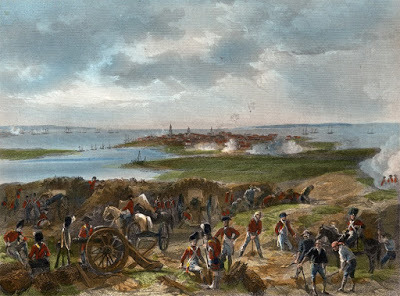 The British capture of Charleston marked a new dynamic in the
The British capture of Charleston marked a new dynamic in the
southern theater of operations
But things changed when the British shifted their strategy to the south. A British force besieged Charleston and its fall and occupation led to a British move to hold all the key positions in the state. The decisive defeat of the Continental forces under General Horatio Gates by British General Lord Cornwallis made it apparent that the British were here to stay.
The South in Flames
These events reignited the ardor of the Loyalists and they flocked to the colors once more – Fanning with them. Bloody civil war once more erupted across the southern backwoods and this time Fanning was at the forefront of the Loyalist cause. With South Carolina under the the British heel and Cornwallis’s army in control, Fanning and other Loyalist partisan leaders now had a steady stream of weapons and other supplies. With things looking dark for the rebels, Loyalist bands were easy to recruit and equip.
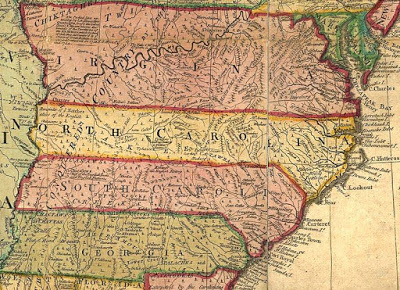 The Southern Theater would prove Decisive
The Southern Theater would prove Decisive
and violent
This high water mark of Loyalist ascendancy did not last long. One of the American cause’s best generals was sent south to instill new energy into the southern theater. Nathanael Green proved a
persistent and classic resistance leader. Giving ground when he had to, making stands, successful and not, but keeping his army in the field and active. Cornwallis had to destroy his army. He hurt it. But could not destroy it.
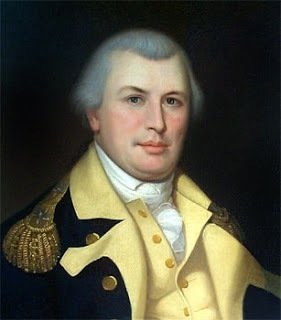 Nathanael Greene's arrival turned the
Nathanael Greene's arrival turned the
tide in the Southern Theater
The West is Lost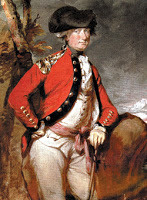 Cornwallis would fail to destroy
Cornwallis would fail to destroy
Greene and make a grave mistakeIn his zeal to pursue the resisting rebel army, Cornwallis used Loyalist units to protect his western flank from patriot militias threatening it. He sent a large Loyalist detachment under his most experienced counter guerrilla leader, Major Patrick Ferguson, to disperse the back woods patriots. Ferguson did not know the locals were being reinforced by a large contingent of "Over Mountain men." Ferguson got caught on King's Mountain. Surrounded, he stood and fought the hated rebels. The battle of Kings Mountain was essentially Loyalist versus patriot affair. The crushing of the Loyalists changed the southern theater in the west to the rebel’s advantage.
With things looking bleak for Loyalists in the west, Fanning took his band and headed east and north to Deep River North Carolina where he conducted operations against local patriots. His success led to his appointment to Colonel of Loyalist militia of Chatham and Randolph counties. For the next several months Fanning ruthlessly launched raids throughout western North Carolina. He now had become one of the most feared Loyalist partisan commanders in the theater.
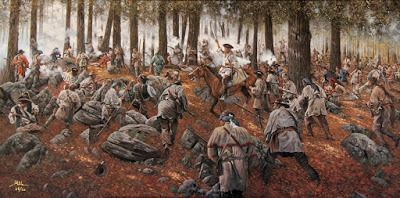 American victory Kings Mountain crushed loyal opposition
American victory Kings Mountain crushed loyal opposition
in the western Carolinas
Guerrilla Days in Carolina
Fanning was a classic guerrilla leader. He would move fast and hit hard, sometimes with as few as 12 men. Many of these raids resulted in the capture and ransom or parole of leading patriot sympathizers and political figures. He was involved in some 36 skirmishes in 1781 alone. One was a raid on a session of court in Chatham County. Fanning’s partisans took 53 prisoners, including court officials, militia officers, and members of the North Carolina General Assembly.
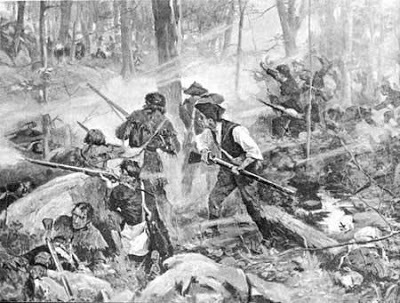 Fanning's Loyalist militia raised Cain among the patriots
Fanning's Loyalist militia raised Cain among the patriots
Fanning led the Loyalist militia at the battle at the House in the Horseshoe in the summer of 1781 where he forced the surrender of a force of patriot militia. By the end of the summer of 1781, Fanning's infamy had attracted a force of approximately 950 Loyalist men to his command. He was ready for the big time.
Conventional War Success… and Failure
With a large force in hand, Fanning was intent on using it. And he did. On 12 September 1781 he led a force of almost 1,000 Loyalists in a surprise assault against the rebel forces at Hillsboro, North Carolina. Hillsboro at the time was the main patriot base in the region and some time capital. He overwhelmed the patriot defenses and captured 200 prisoners along with Governor Thomas Burke. Hillsboro proved his most notable success in the war.
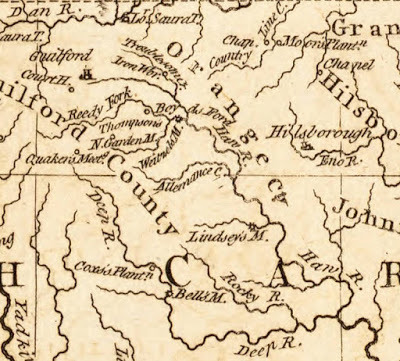 After victory at Hillsboro Fanning is ambushed
After victory at Hillsboro Fanning is ambushed
at Lindley's Mill
But Fanning’s sweet success as a conventional force commander was not long lived. He led his victorious column, along with prisoners, back to Wilmington. As he reached the area around Lindley’s Mill a rebel force of 400 under Brigadier General John Butler launched a fierce attack on Fanning’s men. The fighting was hard and the surprised Loyalist force would have crumbled but for Fanning’s personal leadership. He fended off Butler’s attacks and managed to get his column to Wilmington but was himself badly wounded. Thanks to Fanning's resolve, the hapless Governor Burke was imprisoned by the British Army on James Island near Charleston, South Carolina.
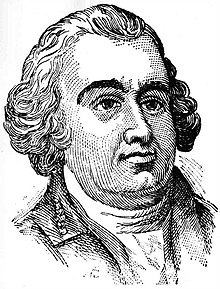
NC Gov Thomas Burke
Decline in Fortunes
In November 1781 the British withdrew from Wilmington on the news of Yorktown. The war seemed over but the Loyalists who remained with the colors would not go down so easily. The bitter civil war left too many desperate for revenge and unwilling to compromise or submit to the rebels they so despised. Fanning was one of them. He continued to lead partisan bands against the patriots. He made a series of bitter attacks on patriot settlements that continued into 1782 – a year that most of us think as one of quiet as the final treaty was negotiate.
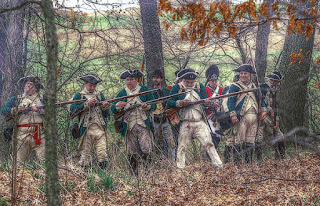 Loyalist Provisionals
Loyalist Provisionals
But Fanning was worn and weary. And the canny backwoodsman saw the hand writing on the wall. It was time to return to a normal life. As a first step in attempting to establish that life, he married Sarah Carr, a 16-year-old young woman from the settlement of Deep River, North Carolina.
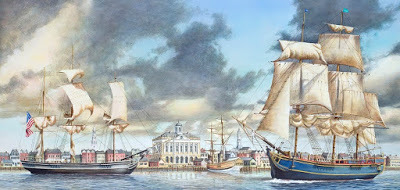 Charleston Harbor would provide many Loyalists'
Charleston Harbor would provide many Loyalists'
final glimpse of the country the fought so hard to keep loyal
Fanning finally accepted a conditional truce from the local American government and agreed to suspend further military action. Now resigned to his fate and that of his cause, Fanning and his young bride went to Charleston where he was deported, with other Loyalists, to British Florida. Fanning’s success against the patriots and his notoriety as a guerrilla caused the North Carolina legislature to ban him from ever entering the state. This seems a bitter memorial to his accomplishments.
Oh Canada!
Like so many other members of the Loyalist diaspora, Fanning did not remain long in his first refuge. After a few months he made his way to New Brunswick, Canada – one of thousands who went there for a better life under the crown. His natural leadership put him in the legislative assembly until he was caught up in a shocking scandal in 1800. Fanning was charged and convicted of rape of 15-year old Sarah London and sentenced to be hanged. The evidence against him was scanty – essentially her testimony, but Fanning had few friends among his Loyalist peers. The combative man from the hills had brought his feisty ways to Canada. He appealed the sentence and was instead of hanging he was banished from New Brunswick.
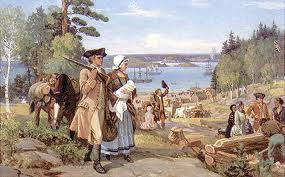 Canada provided refuge for many Loyalists
Canada provided refuge for many Loyalists
after the American Revolution
Fanning proved resourceful when given a second chance. He moved to the small port town of Digby, Nova Scotia. Fanning spent the remainder of his life in Digby. He built a comfortable house and engaged in farming, fishing, and shipbuilding. He still wanted to return to New Brunswick to settle his financial affairs but his petitions to Thomas Carleton, Provincial Secretary Jonathan Odell, and other officials fell on deaf ears.
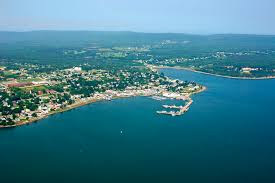 Digby, Nova Scotia was one of many
Digby, Nova Scotia was one of many
Loyalist landing places in Canada
In any case, considering his eight years of fighting and mayhem,the staunch and loyal David Fanning, managed to live to a reasonably ripe old age. He died on 14 March 1825.
A Loyal Life well Lived?
The tough and wiry Fanning was stubborn and determined man in war and peace. As a Loyalist militia leader he proved zealous and often brilliantly effective. But he was not gentile nor was he that type of intellectual loyalist, refined and smug, who sat out the war in the secure comforts of New York, Charleston, or England. Instead, Fanning fought tenaciously, fiercely, and occasionally cruelly against ex-friends and neighbors. Rather than endearing him, his successes made him unpopular with the privileged Loyalist gentry of New Brunswick.
But the last laugh and irony from this angry and combative former hillbilly was his epitaph in the Trinity churchyard at Digby: “Humane, affable, gentle, and kind – A plain honest open moral mind.”
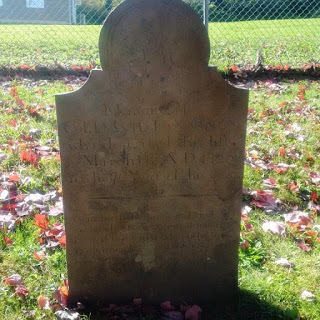 Colonel David Fanning resting place
Colonel David Fanning resting place
in Digby, Nova Scotia
In my take it should have read: “I’m Loyal – Love it or Shove it.”
Life in the back Hills
David Fanning was born in Birch Swamp, Amelia County, Virginia in 1755. In July 1764 Fanning was orphaned. As a result the young David was bound to Needham Bryan (Bryant), a county justice in Johnson County, North Carolina. The justice provided for his education but was by Fanning’s account, harsh. Or maybe young David was a bit of handful. So in 1773, when Fanning was 18 and of legal age, he left his guardian and moved to Raeburn’s Creek in the western section of South Carolina. There the young man farmed and traded with the nearby Cherokee Indians. Although life on the frontier was not easy, it was reasonably good for for the enterprising young David Fanning.
 Fanning in the back country
Fanning in the back countryThings began to change when the American Revolution broke out in 1775. At the time, Fanning was a company sergeant in the Upper Saluda militia of South Carolina. Most up country Carolinians were sympathetic to the crown and eyed the lowland planters and merchants with suspicion. There was friction. A delegation from the low lands established a tenuous truce that was broken when a local Loyalist was arrested in November. Soon rumors spread that the rebels were enticing the Indians to their side. That was it. Accosted and robbed by patriot militias, Fanning sided with the local Loyalist faction.
Fighting for the King
David Fanning served under Major Joseph Robinson in military operations in western South Carolina. He was part of the force that captured a large Patriot garrison at the key Fort Ninety Six in November 1775. But Fanning himself was nearly captured in December that year during the battle at Big Cane Break. Eluding the local patriots, Fanning fled to the Cherokee Indians.
 The Fort at Ninety Six
The Fort at Ninety SixNow wanted as a notorious Loyalist, Fanning was taken prisoner by the rebels in January 1776. This was the first of what be a possible record 14 times during the war! In some of these he was paroled but the cunning and relentless Fanning made numerous harrowing escapes. Between these periods of imprisonment Fanning proved a ruthless, enterprising and aggressive Loyalist officer. He relentlessly led partisan units in almost nonstop skirmishes with the rebel forces in the area. He was a key figure in the little known but decisive back woods civil war that would eventually turn the Carolinians against their British masters and those Loyalist supporters of the crown.
 David Fanning made numerous escapes
David Fanning made numerous escapesThe Loyalists take a Knee
But by August 1779, most of the Loyalists were losing heart. They had suffered heavy losses and it looked like the south would be lost to the crown. Many of them, including Fanning, agreed to a conditional pardon by Governor John Rutledge. This kept Fanning out of the fray for several months. Fanning’s numerous escapades had taken a toll on him. By his own admission he was worn out, frazzled and skeletal in appearance. His many wounds and injuries had taken their toll. Fanning had even agreed to guide patriot militia units in the back country as part of his pardon.
 The British capture of Charleston marked a new dynamic in the
The British capture of Charleston marked a new dynamic in thesouthern theater of operations
But things changed when the British shifted their strategy to the south. A British force besieged Charleston and its fall and occupation led to a British move to hold all the key positions in the state. The decisive defeat of the Continental forces under General Horatio Gates by British General Lord Cornwallis made it apparent that the British were here to stay.
The South in Flames
These events reignited the ardor of the Loyalists and they flocked to the colors once more – Fanning with them. Bloody civil war once more erupted across the southern backwoods and this time Fanning was at the forefront of the Loyalist cause. With South Carolina under the the British heel and Cornwallis’s army in control, Fanning and other Loyalist partisan leaders now had a steady stream of weapons and other supplies. With things looking dark for the rebels, Loyalist bands were easy to recruit and equip.
 The Southern Theater would prove Decisive
The Southern Theater would prove Decisiveand violent
This high water mark of Loyalist ascendancy did not last long. One of the American cause’s best generals was sent south to instill new energy into the southern theater. Nathanael Green proved a
persistent and classic resistance leader. Giving ground when he had to, making stands, successful and not, but keeping his army in the field and active. Cornwallis had to destroy his army. He hurt it. But could not destroy it.
 Nathanael Greene's arrival turned the
Nathanael Greene's arrival turned thetide in the Southern Theater
The West is Lost
 Cornwallis would fail to destroy
Cornwallis would fail to destroyGreene and make a grave mistakeIn his zeal to pursue the resisting rebel army, Cornwallis used Loyalist units to protect his western flank from patriot militias threatening it. He sent a large Loyalist detachment under his most experienced counter guerrilla leader, Major Patrick Ferguson, to disperse the back woods patriots. Ferguson did not know the locals were being reinforced by a large contingent of "Over Mountain men." Ferguson got caught on King's Mountain. Surrounded, he stood and fought the hated rebels. The battle of Kings Mountain was essentially Loyalist versus patriot affair. The crushing of the Loyalists changed the southern theater in the west to the rebel’s advantage.
With things looking bleak for Loyalists in the west, Fanning took his band and headed east and north to Deep River North Carolina where he conducted operations against local patriots. His success led to his appointment to Colonel of Loyalist militia of Chatham and Randolph counties. For the next several months Fanning ruthlessly launched raids throughout western North Carolina. He now had become one of the most feared Loyalist partisan commanders in the theater.
 American victory Kings Mountain crushed loyal opposition
American victory Kings Mountain crushed loyal oppositionin the western Carolinas
Guerrilla Days in Carolina
Fanning was a classic guerrilla leader. He would move fast and hit hard, sometimes with as few as 12 men. Many of these raids resulted in the capture and ransom or parole of leading patriot sympathizers and political figures. He was involved in some 36 skirmishes in 1781 alone. One was a raid on a session of court in Chatham County. Fanning’s partisans took 53 prisoners, including court officials, militia officers, and members of the North Carolina General Assembly.
 Fanning's Loyalist militia raised Cain among the patriots
Fanning's Loyalist militia raised Cain among the patriotsFanning led the Loyalist militia at the battle at the House in the Horseshoe in the summer of 1781 where he forced the surrender of a force of patriot militia. By the end of the summer of 1781, Fanning's infamy had attracted a force of approximately 950 Loyalist men to his command. He was ready for the big time.
Conventional War Success… and Failure
With a large force in hand, Fanning was intent on using it. And he did. On 12 September 1781 he led a force of almost 1,000 Loyalists in a surprise assault against the rebel forces at Hillsboro, North Carolina. Hillsboro at the time was the main patriot base in the region and some time capital. He overwhelmed the patriot defenses and captured 200 prisoners along with Governor Thomas Burke. Hillsboro proved his most notable success in the war.
 After victory at Hillsboro Fanning is ambushed
After victory at Hillsboro Fanning is ambushedat Lindley's Mill
But Fanning’s sweet success as a conventional force commander was not long lived. He led his victorious column, along with prisoners, back to Wilmington. As he reached the area around Lindley’s Mill a rebel force of 400 under Brigadier General John Butler launched a fierce attack on Fanning’s men. The fighting was hard and the surprised Loyalist force would have crumbled but for Fanning’s personal leadership. He fended off Butler’s attacks and managed to get his column to Wilmington but was himself badly wounded. Thanks to Fanning's resolve, the hapless Governor Burke was imprisoned by the British Army on James Island near Charleston, South Carolina.

NC Gov Thomas Burke
Decline in Fortunes
In November 1781 the British withdrew from Wilmington on the news of Yorktown. The war seemed over but the Loyalists who remained with the colors would not go down so easily. The bitter civil war left too many desperate for revenge and unwilling to compromise or submit to the rebels they so despised. Fanning was one of them. He continued to lead partisan bands against the patriots. He made a series of bitter attacks on patriot settlements that continued into 1782 – a year that most of us think as one of quiet as the final treaty was negotiate.
 Loyalist Provisionals
Loyalist ProvisionalsBut Fanning was worn and weary. And the canny backwoodsman saw the hand writing on the wall. It was time to return to a normal life. As a first step in attempting to establish that life, he married Sarah Carr, a 16-year-old young woman from the settlement of Deep River, North Carolina.
 Charleston Harbor would provide many Loyalists'
Charleston Harbor would provide many Loyalists'final glimpse of the country the fought so hard to keep loyal
Fanning finally accepted a conditional truce from the local American government and agreed to suspend further military action. Now resigned to his fate and that of his cause, Fanning and his young bride went to Charleston where he was deported, with other Loyalists, to British Florida. Fanning’s success against the patriots and his notoriety as a guerrilla caused the North Carolina legislature to ban him from ever entering the state. This seems a bitter memorial to his accomplishments.
Oh Canada!
Like so many other members of the Loyalist diaspora, Fanning did not remain long in his first refuge. After a few months he made his way to New Brunswick, Canada – one of thousands who went there for a better life under the crown. His natural leadership put him in the legislative assembly until he was caught up in a shocking scandal in 1800. Fanning was charged and convicted of rape of 15-year old Sarah London and sentenced to be hanged. The evidence against him was scanty – essentially her testimony, but Fanning had few friends among his Loyalist peers. The combative man from the hills had brought his feisty ways to Canada. He appealed the sentence and was instead of hanging he was banished from New Brunswick.
 Canada provided refuge for many Loyalists
Canada provided refuge for many Loyalistsafter the American Revolution
Fanning proved resourceful when given a second chance. He moved to the small port town of Digby, Nova Scotia. Fanning spent the remainder of his life in Digby. He built a comfortable house and engaged in farming, fishing, and shipbuilding. He still wanted to return to New Brunswick to settle his financial affairs but his petitions to Thomas Carleton, Provincial Secretary Jonathan Odell, and other officials fell on deaf ears.
 Digby, Nova Scotia was one of many
Digby, Nova Scotia was one of manyLoyalist landing places in Canada
In any case, considering his eight years of fighting and mayhem,the staunch and loyal David Fanning, managed to live to a reasonably ripe old age. He died on 14 March 1825.
A Loyal Life well Lived?
The tough and wiry Fanning was stubborn and determined man in war and peace. As a Loyalist militia leader he proved zealous and often brilliantly effective. But he was not gentile nor was he that type of intellectual loyalist, refined and smug, who sat out the war in the secure comforts of New York, Charleston, or England. Instead, Fanning fought tenaciously, fiercely, and occasionally cruelly against ex-friends and neighbors. Rather than endearing him, his successes made him unpopular with the privileged Loyalist gentry of New Brunswick.
But the last laugh and irony from this angry and combative former hillbilly was his epitaph in the Trinity churchyard at Digby: “Humane, affable, gentle, and kind – A plain honest open moral mind.”
 Colonel David Fanning resting place
Colonel David Fanning resting placein Digby, Nova Scotia
In my take it should have read: “I’m Loyal – Love it or Shove it.”
Published on April 28, 2019 08:27
March 31, 2019
The Legend and the Legion
Polish Bad Ass
In a war that saw many "bad asses" serve on both sides, Kasimierz (Casimir) Pulaski has to be ranked near the top. And if not for a stray round of grape, he may have fought his way to the top of the list. He fought for freedom on two continents and remained undaunted throughout a career of professional set backs. Although he never saw his homeland freed, he managed to help nudge a nascent republic to a hard fought freedom. Something tells me he was glad to sacrifice himself in a cause that changed the world.
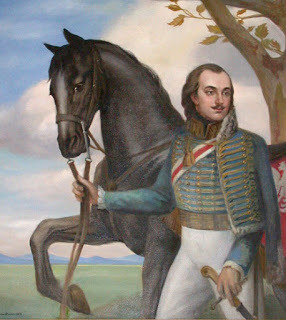 Bad Ass on two continents
Bad Ass on two continents
Lineage
Kasimierz (Casimir) Pulaski was born in Podolia, Poland on 4 March 1747, son of Count Josef Pulaski, a member of the minor Polish gentry. He came from a family of knightly traditions - mostly warfare. Pulaski’s family fought under Poland’s King John III Sobieski against the Turks in the 17th century – a campaign that saved Europe. At the siege of Vienna in September 1683, the decisive battle of the campaign, the famed Polish winged hussars, heavily armored lancers, charged home against a mighty Turkish host and sent it in a retreat that would eventually begin the long decline of the Ottoman Empire. It was from the line of these bold horsemen that Pulaski sprang.
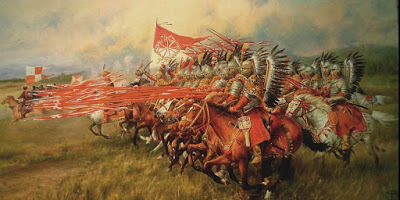 Charge of Winged Hussars at Vienna
Charge of Winged Hussars at Vienna
Fighting For Poland
And Poland needed men of fighting blood. For by the time of Kasimierz’s birth, the once mighty Polish Lithuanian Commonwealth was under intense political pressure from its increasingly powerful neighbors. Austria, Prussia and Russia had managed to manipulate the weak King Stanislaw II. Pulaski was well educated, and in 1768 he joined the Confederation of the Bars, established by his father to fight the Russians. He fought in several successful actions, including the famous defense of the monastery fortress of Czestochowa in 1771, but eventually suffered defeat and was exiled to Turkey. As a result, Poland went through its first partition (of three). Pulaski spent his years in Turkey trying to stir them against their common threat, the Russians. When this failed he sailed for France, now penniless and broken. But then he heard of the American Revolution!
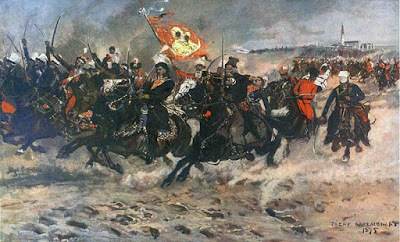 Pulaski leading forces of the Bar Confederation
Pulaski leading forces of the Bar Confederation
at Czestochowa in 1771
Fighting for Freedom
If he could not free Poland, he would offer his sword for a new cause for freedom. Pulaski approached the American agents in France, Silas Deane and Benjamin Franklin, seeking a commission in the Continental Army. Franklin provided him a letter of introduction and the excited nobleman sailed for Boston in July 1777. After conferring with members of the Continental Congress, the young Pole volunteered his services to General George Washington as an aide. He served beside Washington at the Battle of Brandywine on 11 September 1777. Although this proved a defeat for the Americans, quick and decisive actions by Pulaski may have saved the Continental Army from complete destruction. He fought at Germantown covering Washington's retreat, patrolled the area around Valley Forge during the winter, moved to Trenton and then, under Gen. Anthony Wayne, he fought the British at Haddersfield, New Jersey.
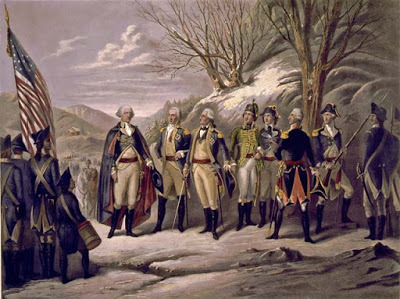 Pulaski was one of many foreign officers who
Pulaski was one of many foreign officers who
served the cause of freedom
Failure to Communicate
Nobody questioned Pulaski’s heroism under fire, nor his commitment to the Cause, but he was quarrelsome, headstrong and overly sensitive to matters of rank – as were many of the Americans. The difficulties arising from his hot temper were compounded by his lack of English – he used French often to communicate. His feuding and fussing came to a head when he had a falling out in the spring of 1778 with General Anthony Wayne, no slouch himself when came to anger. Pulaski threatened to resign over it. Washington convinced him to stay with the army and petitioned Congress for a separate command for him. This was granted and on 28 March 1778 Congress authorized Kazimierz Pulaski to raise a unit soon to be named the Pulaski Legion.
I am Legion
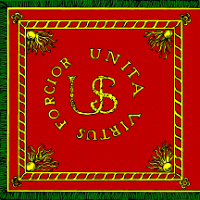 The Legion's BannerA legion is an archaic term for a combined arms force. During the Revolutionary War this usually meant infantry and cavalry – but occasionally some light cannon were in the mix. The Pulaski Legion was recruited around Baltimore and was comprised of Americans, German, Frenchmen, Irishmen, and Poles. It flew a red banner. Pulaski’s unit initially numbered 200 infantry and 68 cavalry armed, wait for it… lances. Polish cavalry were renowned for their lancer units, which usually charged home to victory over Cossacks, Russians, Turks and Germans. No wonder the gallant Pole created his own version.
The Legion's BannerA legion is an archaic term for a combined arms force. During the Revolutionary War this usually meant infantry and cavalry – but occasionally some light cannon were in the mix. The Pulaski Legion was recruited around Baltimore and was comprised of Americans, German, Frenchmen, Irishmen, and Poles. It flew a red banner. Pulaski’s unit initially numbered 200 infantry and 68 cavalry armed, wait for it… lances. Polish cavalry were renowned for their lancer units, which usually charged home to victory over Cossacks, Russians, Turks and Germans. No wonder the gallant Pole created his own version.
The Legion would see immediate action along the New Jersey coast where it tasted first blood at Egg Harbor on 4 October 1778. Unfortunately, it did not cover itself in glory. The famed British Major Patrick Ferguson led his own legion and surprised Pulaski’s force in camp. They took heavy casualties. Turns out one of Pulaski’s men deserted and provided the British intelligence on the unit’s dispositions.
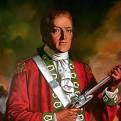 Major Patrick Ferguson
Major Patrick Ferguson
Washington sent Pulaski’s unit to a quiet area to recuperate. The Legion garrisoned the upper Delaware to protect against Indian raids. Pulaski’s honor was affronted and he fumed over the assignment. His flinty ways led to another incident. Pulaski court martialed his subordinate, Major Stephen Moylan over an alleged slight. He also threatened once more to resign. With the patience of Job, General Washington interceded once more. He reassigned the quarrelsome Pole and his Legion to the Southern theater.
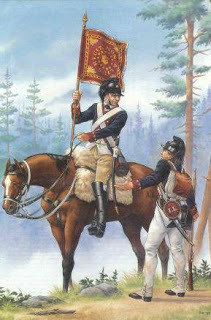 Cavalry and Infantry of the Legion
Cavalry and Infantry of the Legion
Since the center of gravity had shifted south, this action both removed Pulaski from under Washington’s direct supervision. But it was sure to give him real fighting to match his combative ways.
For the South
So in the spring of 1779, Pulaski and his Legion joined American forces defending Charleston, South Carolina. He arrived in time for a whirlwind! The British strategy had shifted to the south, hoping an overwhelming show of force would break the will of the patriots in the region. In late 1778 they had taken Savannah, Georgia. Now they aimed to slide north to the Carolinas.
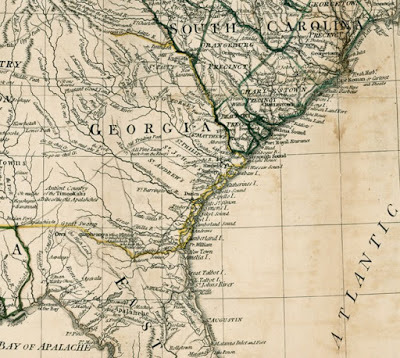 The British Strategy turned South to separate
The British Strategy turned South to separate
the Carolinas and Georgia from the rebellion
The British under General Augustin Prevost threatened the southern capital and threatened a siege. In a bold move, Pulaski attacked the British on 11 May 1779. Greatly outnumbered, the Legion was thrashed and repulsed. When he returned to the city, he learned that morale was low and patriot resolve ebbing. The unflinching Pulaski encouraged the inhabitants not to surrender so easily. They held out long enough for the American southern commander, General Benjamin Lincoln, to arrive with reinforcements. Pulaski frequently suffered from bouts of malaria acquired in the south’s hot swampy coastal lowlands. But the stubborn and proud officer refused to leave active service.
At the beginning of September, General Lincoln prepared to launch an attempt to retake Savannah with long awaited French assistance. Cavalry would play a role and Pulaski was sent to Augusta, Georgia to join General Lachlan McIntosh. Lachlan and Pulaski’s force covered the advance of Lincoln’s offensive. Pulaski captured a British outpost near Ogeechee River. His Legion then acted as an advance guard for the allied French units under Admiral Charles Hector, Comte d'Estaing.
But d’Estaing was on a short timeline. Reliant on his naval support, and with hurricane season fast approaching, he decided to stake everything on a surprise attack on 9 October 1779. Pulaski was given command of the entire combined Franco-American cavalry force. Pulaski, ever impetuous, launched a full scale cavalry charge against heavily defended British fortification. But Pulaski took a ball of grape shot and the assault was soundly defeated.
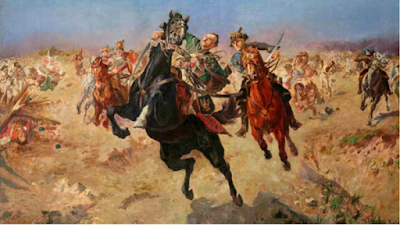 Pulaski mortally wounded by grape shot
Pulaski mortally wounded by grape shot
Mortally wounded, Pulaski was moved to a transport ship Wasp in the hope of getting him to Charleston. But the gallant Pulaski died two days later – 11 February 1779. They buried him at sea. And his Legion? His men were transferred under Colonel Charles Armand’s legion for the remainder of the war.
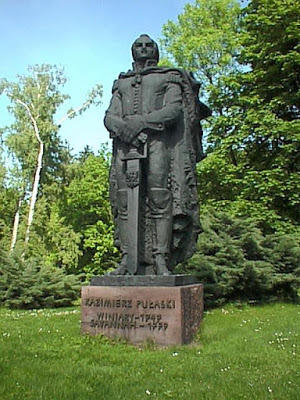 Pulaski monument in his native Poland
Pulaski monument in his native Poland
Legacy
Despite his haughty and quarrelsome character, Casimir Pulaski is remembered in many ways. Of course, in Poland, as a man who fought for freedom on two continents and bears the title "Soldier of Liberty." In America, his service and sacrifices are commemorated by the many streets, bridges, counties, and towns that bear his name.
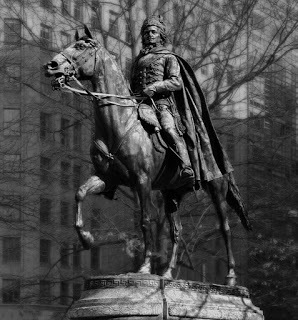 Monument to Pulaski in Washington, DC
Monument to Pulaski in Washington, DC
Pulaski gave the last full measure outside Savannah, Georgia, and there a large monument commemorates his sacrifice fighting for the city during the American Revolution. In 1833, the new fort being constructed on Cockspur Island outside of Savannah was christened Fort Pulaski in honor of Casimir Pulaski.
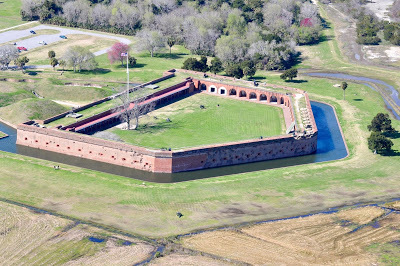 Fort Pulaski
Fort Pulaski
Above all, he is the man who provided the American colonists with their first true legion on horseback. The US cavalry later adopted its guidons in red and white, the national colors of Poland, to honor the boldest cavalryman of the War for Independence, and forever cementing his place as "The Father of the American Cavalry."
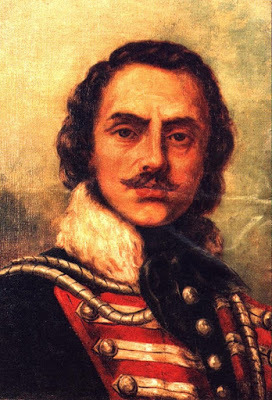
In a war that saw many "bad asses" serve on both sides, Kasimierz (Casimir) Pulaski has to be ranked near the top. And if not for a stray round of grape, he may have fought his way to the top of the list. He fought for freedom on two continents and remained undaunted throughout a career of professional set backs. Although he never saw his homeland freed, he managed to help nudge a nascent republic to a hard fought freedom. Something tells me he was glad to sacrifice himself in a cause that changed the world.
 Bad Ass on two continents
Bad Ass on two continentsLineage
Kasimierz (Casimir) Pulaski was born in Podolia, Poland on 4 March 1747, son of Count Josef Pulaski, a member of the minor Polish gentry. He came from a family of knightly traditions - mostly warfare. Pulaski’s family fought under Poland’s King John III Sobieski against the Turks in the 17th century – a campaign that saved Europe. At the siege of Vienna in September 1683, the decisive battle of the campaign, the famed Polish winged hussars, heavily armored lancers, charged home against a mighty Turkish host and sent it in a retreat that would eventually begin the long decline of the Ottoman Empire. It was from the line of these bold horsemen that Pulaski sprang.
 Charge of Winged Hussars at Vienna
Charge of Winged Hussars at ViennaFighting For Poland
And Poland needed men of fighting blood. For by the time of Kasimierz’s birth, the once mighty Polish Lithuanian Commonwealth was under intense political pressure from its increasingly powerful neighbors. Austria, Prussia and Russia had managed to manipulate the weak King Stanislaw II. Pulaski was well educated, and in 1768 he joined the Confederation of the Bars, established by his father to fight the Russians. He fought in several successful actions, including the famous defense of the monastery fortress of Czestochowa in 1771, but eventually suffered defeat and was exiled to Turkey. As a result, Poland went through its first partition (of three). Pulaski spent his years in Turkey trying to stir them against their common threat, the Russians. When this failed he sailed for France, now penniless and broken. But then he heard of the American Revolution!
 Pulaski leading forces of the Bar Confederation
Pulaski leading forces of the Bar Confederationat Czestochowa in 1771
Fighting for Freedom
If he could not free Poland, he would offer his sword for a new cause for freedom. Pulaski approached the American agents in France, Silas Deane and Benjamin Franklin, seeking a commission in the Continental Army. Franklin provided him a letter of introduction and the excited nobleman sailed for Boston in July 1777. After conferring with members of the Continental Congress, the young Pole volunteered his services to General George Washington as an aide. He served beside Washington at the Battle of Brandywine on 11 September 1777. Although this proved a defeat for the Americans, quick and decisive actions by Pulaski may have saved the Continental Army from complete destruction. He fought at Germantown covering Washington's retreat, patrolled the area around Valley Forge during the winter, moved to Trenton and then, under Gen. Anthony Wayne, he fought the British at Haddersfield, New Jersey.
 Pulaski was one of many foreign officers who
Pulaski was one of many foreign officers whoserved the cause of freedom
Failure to Communicate
Nobody questioned Pulaski’s heroism under fire, nor his commitment to the Cause, but he was quarrelsome, headstrong and overly sensitive to matters of rank – as were many of the Americans. The difficulties arising from his hot temper were compounded by his lack of English – he used French often to communicate. His feuding and fussing came to a head when he had a falling out in the spring of 1778 with General Anthony Wayne, no slouch himself when came to anger. Pulaski threatened to resign over it. Washington convinced him to stay with the army and petitioned Congress for a separate command for him. This was granted and on 28 March 1778 Congress authorized Kazimierz Pulaski to raise a unit soon to be named the Pulaski Legion.
I am Legion
 The Legion's BannerA legion is an archaic term for a combined arms force. During the Revolutionary War this usually meant infantry and cavalry – but occasionally some light cannon were in the mix. The Pulaski Legion was recruited around Baltimore and was comprised of Americans, German, Frenchmen, Irishmen, and Poles. It flew a red banner. Pulaski’s unit initially numbered 200 infantry and 68 cavalry armed, wait for it… lances. Polish cavalry were renowned for their lancer units, which usually charged home to victory over Cossacks, Russians, Turks and Germans. No wonder the gallant Pole created his own version.
The Legion's BannerA legion is an archaic term for a combined arms force. During the Revolutionary War this usually meant infantry and cavalry – but occasionally some light cannon were in the mix. The Pulaski Legion was recruited around Baltimore and was comprised of Americans, German, Frenchmen, Irishmen, and Poles. It flew a red banner. Pulaski’s unit initially numbered 200 infantry and 68 cavalry armed, wait for it… lances. Polish cavalry were renowned for their lancer units, which usually charged home to victory over Cossacks, Russians, Turks and Germans. No wonder the gallant Pole created his own version.The Legion would see immediate action along the New Jersey coast where it tasted first blood at Egg Harbor on 4 October 1778. Unfortunately, it did not cover itself in glory. The famed British Major Patrick Ferguson led his own legion and surprised Pulaski’s force in camp. They took heavy casualties. Turns out one of Pulaski’s men deserted and provided the British intelligence on the unit’s dispositions.
 Major Patrick Ferguson
Major Patrick FergusonWashington sent Pulaski’s unit to a quiet area to recuperate. The Legion garrisoned the upper Delaware to protect against Indian raids. Pulaski’s honor was affronted and he fumed over the assignment. His flinty ways led to another incident. Pulaski court martialed his subordinate, Major Stephen Moylan over an alleged slight. He also threatened once more to resign. With the patience of Job, General Washington interceded once more. He reassigned the quarrelsome Pole and his Legion to the Southern theater.
 Cavalry and Infantry of the Legion
Cavalry and Infantry of the LegionSince the center of gravity had shifted south, this action both removed Pulaski from under Washington’s direct supervision. But it was sure to give him real fighting to match his combative ways.
For the South
So in the spring of 1779, Pulaski and his Legion joined American forces defending Charleston, South Carolina. He arrived in time for a whirlwind! The British strategy had shifted to the south, hoping an overwhelming show of force would break the will of the patriots in the region. In late 1778 they had taken Savannah, Georgia. Now they aimed to slide north to the Carolinas.
 The British Strategy turned South to separate
The British Strategy turned South to separatethe Carolinas and Georgia from the rebellion
The British under General Augustin Prevost threatened the southern capital and threatened a siege. In a bold move, Pulaski attacked the British on 11 May 1779. Greatly outnumbered, the Legion was thrashed and repulsed. When he returned to the city, he learned that morale was low and patriot resolve ebbing. The unflinching Pulaski encouraged the inhabitants not to surrender so easily. They held out long enough for the American southern commander, General Benjamin Lincoln, to arrive with reinforcements. Pulaski frequently suffered from bouts of malaria acquired in the south’s hot swampy coastal lowlands. But the stubborn and proud officer refused to leave active service.
At the beginning of September, General Lincoln prepared to launch an attempt to retake Savannah with long awaited French assistance. Cavalry would play a role and Pulaski was sent to Augusta, Georgia to join General Lachlan McIntosh. Lachlan and Pulaski’s force covered the advance of Lincoln’s offensive. Pulaski captured a British outpost near Ogeechee River. His Legion then acted as an advance guard for the allied French units under Admiral Charles Hector, Comte d'Estaing.
But d’Estaing was on a short timeline. Reliant on his naval support, and with hurricane season fast approaching, he decided to stake everything on a surprise attack on 9 October 1779. Pulaski was given command of the entire combined Franco-American cavalry force. Pulaski, ever impetuous, launched a full scale cavalry charge against heavily defended British fortification. But Pulaski took a ball of grape shot and the assault was soundly defeated.
 Pulaski mortally wounded by grape shot
Pulaski mortally wounded by grape shotMortally wounded, Pulaski was moved to a transport ship Wasp in the hope of getting him to Charleston. But the gallant Pulaski died two days later – 11 February 1779. They buried him at sea. And his Legion? His men were transferred under Colonel Charles Armand’s legion for the remainder of the war.
 Pulaski monument in his native Poland
Pulaski monument in his native PolandLegacy
Despite his haughty and quarrelsome character, Casimir Pulaski is remembered in many ways. Of course, in Poland, as a man who fought for freedom on two continents and bears the title "Soldier of Liberty." In America, his service and sacrifices are commemorated by the many streets, bridges, counties, and towns that bear his name.
 Monument to Pulaski in Washington, DC
Monument to Pulaski in Washington, DCPulaski gave the last full measure outside Savannah, Georgia, and there a large monument commemorates his sacrifice fighting for the city during the American Revolution. In 1833, the new fort being constructed on Cockspur Island outside of Savannah was christened Fort Pulaski in honor of Casimir Pulaski.
 Fort Pulaski
Fort PulaskiAbove all, he is the man who provided the American colonists with their first true legion on horseback. The US cavalry later adopted its guidons in red and white, the national colors of Poland, to honor the boldest cavalryman of the War for Independence, and forever cementing his place as "The Father of the American Cavalry."

Published on March 31, 2019 08:05
February 23, 2019
The First Baronet
Who is Peter Parker?
This edition of the Yankee Doodle Spies will relate the exploits of one Peter Parker. No, not that Peter Parker. Our Peter Parker was not a web crawling teen like his comic book namesake. But before he was a teen, he was skipping along the rigging with a speed and grace that would make even a Spider Man jealous. This is our first naval topic in a while and focuses on a little known British sailor who rose through the ranks through long service, a little patronage, good timing and courage. Sometimes all it takes to rise to the top is just being there.
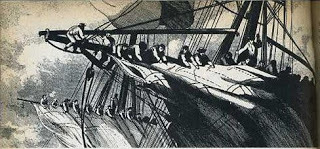 Skipping up the rigging
Skipping up the rigging
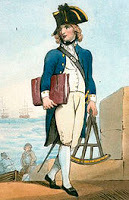 Midshipman
Midshipman
Our Peter Parker was born in Ireland in 1721, the son of Vice Admiral Christopher Parker. Like all the legacy officers of the Royal Navy, he started early, serving as a cabin boy and midshipman. In this capacity he served on several vessels under Vice-Admiral Edward Vernon of the West Indies station at the start of the War of Jenkins' Ear.
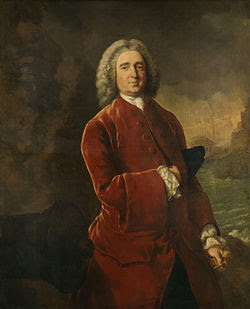 Vice Adm Sir Edward Vernon
Vice Adm Sir Edward Vernon
War of the Austrian Succession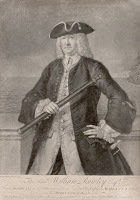 Rear Admiral
Rear Admiral
Sir William Rowley
The eight-year War of the Austrian Succession would provide plenty of action for the Royal Navy and lots of opportunities for up and coming young officers like young Peter. Parker received his lieutenant’s commission in the summer of 1743 aboard the HMS Russell, a second rate 80-gun ship of the line. He served on several warships at various stations. Most notably the Mediterranean, where he took part in the battle of Toulon on 11 February 1744 aboard the flagship of Rear-Admiral William Rowley, the 90-gun HMS Barfleur.
In May 1747 he made captain and commissioned a captured French privateer as the 24-gun frigate HMS Margate. Captain Parker commanded this vessel in the Channel, North Sea and the Mediterranean, and when she was paid off in April 1749, he had a short stint aboard the 66-gun HMS Lancaster before going on half-pay with the war’s end. It was common practice to place officers on half pay in between “hot” wars.
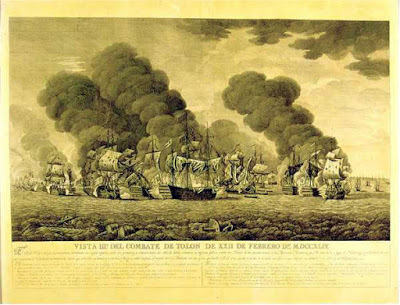 Young Lieutenant Parker served at Toulon
Young Lieutenant Parker served at Toulon
Seven Years of War
Captain Parker remained ashore on half-pay for several years while supervising construction of the 44-gun HMS Woolwich at Portsmouth. With the outbreak of the Seven Years’ war, he took to sea on the Woolwich and commanded it on a voyage to the Baltic Sea. But he fell badly ill during the voyage when he caught a fever that swept through the ship.
After he recovered, the navy sent him to the Leeward Islands in December 1756 where in January 1759 he transferred to the 50-gun HMS Bristol. Parker commanded the Bristol in the unsuccessful campaign against Martinique and later in the campaign that took Guadeloupe.
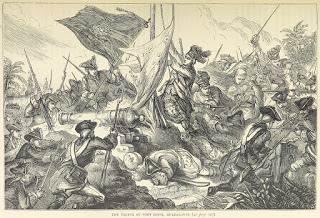 Taking Fort Louis at Guadeloupe was one
Taking Fort Louis at Guadeloupe was one
of many sea-land campaigns in Parker's career
In 1760, he transferred back to home station (the Channel) where he took command of the 64-gun HMS Montague. Parker took several prize-ships while cruising the narrow but deadly waters between Britain and the Continent. His success gained him command of the 70-gun HMS Buckingham and a squadron that reduced French fortifications on the Isle d’Aix. The following year he participated in the assault on a fort at Belle-Isle. This was classic 18th century warfare, reducing posts and gaining chits to negotiate a better peace. But plenty of hot action and naval savvy made this possible. His last wartime command was the 74-gun HMS Terrible just before 1763 Treaty of Paris.
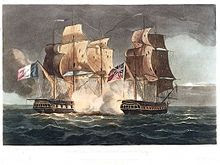 HMS Terrible in action
HMS Terrible in action
Another Half-Pay Hiatus
The 1763 Treaty of Paris consigned Parker and most of his fellow officers on to half-pay. This half pay status was intended to reduce expenses while keeping experienced officers in hand so they could be reactivated for the next war. And in the 18th century Royal Navy, there always was a next war. Parker remained without a command for nearly a decade. But then things got interesting. Knighted in 1772, Sir Peter Parker was given command of the second-rate but heavily armed (90-gun) HMS Barfleur when he rejoined the service in 1773. By 1773 things were heating up in the North America colonies. In 1775 Parker was given command of the fourth rate 50-gun HMS Bristol but more importantly, he would soon receive command of a squadron and promoted to commodore.
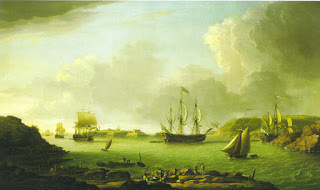 Ships returning to Plymouth
Ships returning to Plymouth
War of Rebellion
In February 1776 Captain Peter Parker was named commodore of a small squadron at Plymouth and ordered to transport several Irish regiments under General Charles Cornwallis to America. Destination: the Cape Fear region of North Carolina. This was part of a complex plan in which he would cooperate with North Carolina’s infamous Royal Governor Josiah Martin and General Henry Clinton in an effort to raise Loyalist support in the troubled colony.
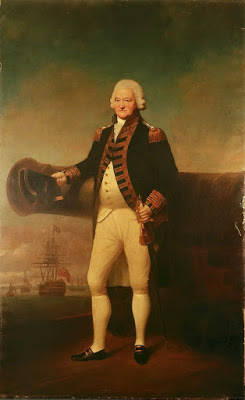 Sir Peter Parker, 1st Baronet
Sir Peter Parker, 1st Baronet
Ill-Fated Southern Rendezvous
Bad weather and bad luck would thwart these efforts. A rough Atlantic voyage ensued, and by the time Parker’s armada reached its rendezvous with Clinton, the expected Loyalist uprising they depended on had been crushed. To their chagrin, they learned of the decisive battle at Moores Creek Bridge on 21 February, 1776. The resettled Scots highlanders of the Carolina hill country had agreed to march to the coast in support of the crown. The irony here was that many had been resettled after the disaster at Culloden decades earlier in Scotland. Now they had taken up the claymore on behalf of the crown that vanquished them in 1745. The highlanders’ attack was easily scattered by the rebels from the coastal tidewater - thus, no force to link up with.
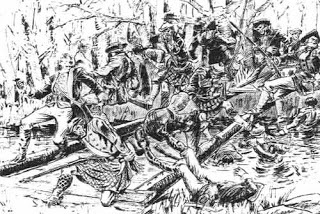 Battle at Moores Creek Bridge
Battle at Moores Creek Bridge
But no armada should ever go to waste, so Parker and Clinton shifted their sights south - on Charleston, South Carolina. The town was seen as weakly defended. Quickly seizing it would provide a good naval base in the south and provide a safe haven for Loyalists throughout the region. The idea of winning hearts and minds was still part of the British approach to the war.
Charleston
On 1 June, 1776, Parker’s flotilla lay off Charleston but the lack of charts (see the Yankee Doodle Spies Blog Post on hydrography) forced the British to sound the waters while they waited for the tides to favor and attack. A good plan under the conditions, but the delay gave the American commander, Colonel William Moultrie, time to improve the defenses of Fort Sullivan on Sullivan’s Island.
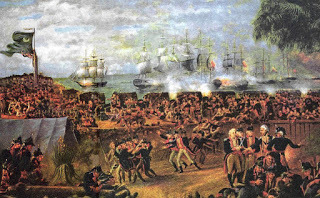 Moultrie's gallant defense of Fort Sullivan
Moultrie's gallant defense of Fort Sullivan
spared the south for a few years
On 28 June, Parker was finally able to land the British troops on Long Island, the island next up the coast to the north-east of Sullivan’s Island, and place ships where they could fire on the island. Despite a horrific bombardment, the defenders held out, protected by Fort Sullivan’s palmetto walls. The spongy bark palmetto logs absorbed cannon fire. The defenders had only a few guns but Moultrie used these to good effect. He concentrated their fire upon Parker’s flag ship, HMS Bristol. In a stroke of ill-luck, the ship’s cable was shot away. Out of control, Bristol swung around, and guns from the fort poured enfilade fire into her.
Our commodore bravely stood his post on the quarterdeck in the finest tradition of the Royal Navy. But a heated cannon ball, deadly red hot shot, seared his pants off his rear end and burned him badly. Meanwhile, things went from bad to worse. To evade capture the frigate HMS Actaeon ran onto shoals and grounded. Under American fire, the savvy British sailors burned their ship to avoid her capture. The intense fighting went on for 10 hours. Finally, with casualties amounting to over 250, Parker signaled the flotilla to break off and they disengaged.
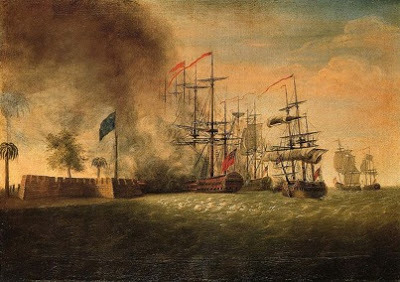 Shoals, palmetto logs and well aimed guns set
Shoals, palmetto logs and well aimed guns set
our commodore's pants afire
Parker’s failure at Charleston saved the south for the glorious cause, at least for a few years. The resultant boost in American morale rallied southern patriots and subdued southern Loyalists. In the kind of war the rebellion was becoming, morale would prove decisive.
True North
With their commodore recovering from his burns, Parker’s flotilla made its way back to New York. There it joined the fleet under Admiral Richard Howe. Commodore Parker recovered enough to command the squadron that captured Long Island in August 1776. There his ships supported the landing of British troops on Long Island, causing the rebel army to be forced from New York City.
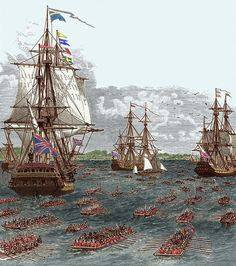 Parker's leadership was part of a brilliant sea-land
Parker's leadership was part of a brilliant sea-land
campaign that resulted in victory on
Long Island and New York
In December,1776, Parker was given command of a flotilla that transported an invasion force under Henry Clinton in another successful venture: seizing Newport, Rhode Island. This provided the British an additional base from which to threaten Massachusetts and Connecticut. More sea-land success for the commodore that would not go unnoticed.
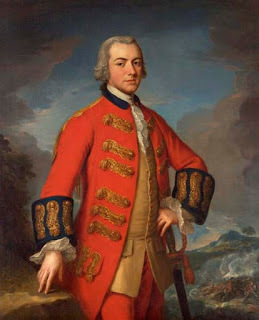 Sir Henry Clinton
Sir Henry Clinton
Commodore Parker remained on station at Rhode Island for almost a year with two 50-gun war ships and several frigates under his command. Despite the seemingly apparent back water assignment, his career was about to pivot him in a higher trajectory: flag rank!
A Flag Officer
 Comte de Grasse Parker was promoted to rear admiral on 28 April 1777. He was soon named commander of the Jamaica Station (not the subway stop). By that time the British strategy had shifted its efforts in securing as much of the West Indies. The remainder of the war was taken with supporting efforts there against the French and Spanish. He executed his duties proficiently and received promotion to rear admiral in March 1779.
Comte de Grasse Parker was promoted to rear admiral on 28 April 1777. He was soon named commander of the Jamaica Station (not the subway stop). By that time the British strategy had shifted its efforts in securing as much of the West Indies. The remainder of the war was taken with supporting efforts there against the French and Spanish. He executed his duties proficiently and received promotion to rear admiral in March 1779.
His time in America came to a close in 1782. Parker returned to England in August of that year. But he had the distinct privilege of carrying the captured French admiral, Francois-Joseph-Paul, Comte de Grasse, and his staff as prisoners from the Battle of the Saintes. Despite defeat at the Saintes, de Grasse gained honors for his victory at the Battle of the Chesapeake in 1781-a rare defeat of the Royal Navy that set the stage for American victory. One can only wonder about the sea stories they shared over wine during the voyage back! In London, de Grasse would set the stage for negotiations leading to the Treaty of Paris ending the American War for Independence.
High Command
Service in American waters brought Parker great distinction, despite Charleston. He was elevated to a baronetcy in 1783, and given command of Portsmouth harbor, home port of the Royal Navy. During that time he met and mentored a young Lieutenant Horatio Nelson, future victor of Trafalgar. Parker facilitated his early career and for that, if nothing else, the British should hold him in esteem. Parker was named admiral of the fleet in September 1799 upon the death of Admiral Lord Howe. He was also named a general of marines. Sadly, one of Parker’s last official acts was to serve as the chief mourner at Vice-Admiral Lord Nelson’s funeral on 9 January 1806.
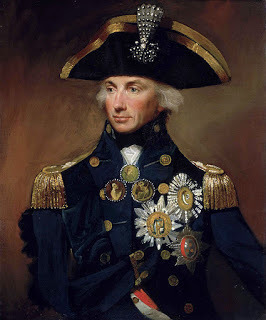 Parker would mentor a young Horatio Nelson
Parker would mentor a young Horatio Nelson
and sadly preside at his funeral
An MP
Not uncommon for military officers at the time, Parker served in parliament as MP for Seaford from 1784-6 In 1787, he became M.P. for Malden, which he held until 1790. Parker’s West Indian prize-money allowed him to build an estate in Essex, although during his parliamentary years his address was given as Basingbourn in Cambridgeshire. He supported the government but only made two speeches during his time in the House of Commons. . As a member of Parliament, Parker was a pro-slaver, stating that “the abolition of the Africa Trade would, in my opinion, cause a general despondency amongst the Negroes and gradually decrease their population and consequently the produce of our islands, and must in time destroy near half our commerce and take from Great Britain all the pretensions to the rank she now holds as the First Maritime power in the World.”
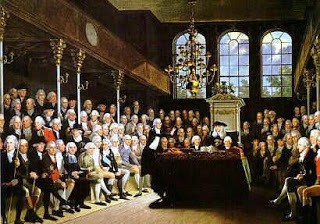 Parliament
Parliament
Family Life
True to his class and position, Parker made a good match in his family life. Parker married Margaret Nugent. They had two sons and two daughters. One son, Christopher, would rise to Vice admiral.
Admiral Sir Peter Parker, 1st Baronet was viewed as tough and opinionated, and well regarded for his composure and coolness in action. After all, how many admirals continued to fight with their pants seared off? Although he was considered cantankerous, he met his match with Margaret. His wife was of a very strong personality, and during his period of command at Jamaica was almost his equal in the management of the station. He died in London, on 21 December 1811 and was buried at St Margaret's, Westminster.
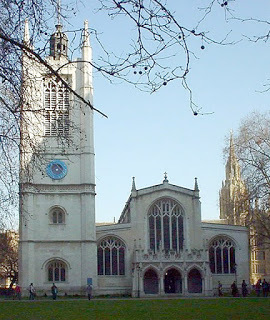 Peter Parker's resting place at
Peter Parker's resting place at
St. Margaret's Church
Legacy
Peter Parker's Forest Gump like career, spanning decades, continents, battles and interaction with a who's who of the 18th century Royal Navy was not uncommon. After all, forging an empire requires such men to put themselves in strange places, often for years at a time. Naval officers often sprang from a line of naval officers. As we can see, Parker's line was pretty darned accomplished. In addition to being the son and father of an admiral, he was also the grandfather of an admiral. Parker's use of patronage rose his son Christopher (who served under him) to captain and then admiral at a very early age. Christopher's son Captain Peter, the celebrated 2d Baronet, also served under his grandfather as well as Horatio Nelson. The second Peter Parker fought in America as did his father and grandfather. This time in the War of 1812, where during combat near Baltimore in 1814, he was shot in the pants like the first Sir Peter. Unfortunately this would was mortal. He too was buried at St. Margaret's.
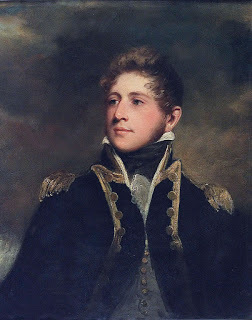 Captain Peter Parker, 2nd Baronet
Captain Peter Parker, 2nd Baronet
This edition of the Yankee Doodle Spies will relate the exploits of one Peter Parker. No, not that Peter Parker. Our Peter Parker was not a web crawling teen like his comic book namesake. But before he was a teen, he was skipping along the rigging with a speed and grace that would make even a Spider Man jealous. This is our first naval topic in a while and focuses on a little known British sailor who rose through the ranks through long service, a little patronage, good timing and courage. Sometimes all it takes to rise to the top is just being there.
 Skipping up the rigging
Skipping up the rigging Midshipman
MidshipmanOur Peter Parker was born in Ireland in 1721, the son of Vice Admiral Christopher Parker. Like all the legacy officers of the Royal Navy, he started early, serving as a cabin boy and midshipman. In this capacity he served on several vessels under Vice-Admiral Edward Vernon of the West Indies station at the start of the War of Jenkins' Ear.
 Vice Adm Sir Edward Vernon
Vice Adm Sir Edward VernonWar of the Austrian Succession
 Rear Admiral
Rear Admiral Sir William Rowley
The eight-year War of the Austrian Succession would provide plenty of action for the Royal Navy and lots of opportunities for up and coming young officers like young Peter. Parker received his lieutenant’s commission in the summer of 1743 aboard the HMS Russell, a second rate 80-gun ship of the line. He served on several warships at various stations. Most notably the Mediterranean, where he took part in the battle of Toulon on 11 February 1744 aboard the flagship of Rear-Admiral William Rowley, the 90-gun HMS Barfleur.
In May 1747 he made captain and commissioned a captured French privateer as the 24-gun frigate HMS Margate. Captain Parker commanded this vessel in the Channel, North Sea and the Mediterranean, and when she was paid off in April 1749, he had a short stint aboard the 66-gun HMS Lancaster before going on half-pay with the war’s end. It was common practice to place officers on half pay in between “hot” wars.
 Young Lieutenant Parker served at Toulon
Young Lieutenant Parker served at ToulonSeven Years of War
Captain Parker remained ashore on half-pay for several years while supervising construction of the 44-gun HMS Woolwich at Portsmouth. With the outbreak of the Seven Years’ war, he took to sea on the Woolwich and commanded it on a voyage to the Baltic Sea. But he fell badly ill during the voyage when he caught a fever that swept through the ship.
After he recovered, the navy sent him to the Leeward Islands in December 1756 where in January 1759 he transferred to the 50-gun HMS Bristol. Parker commanded the Bristol in the unsuccessful campaign against Martinique and later in the campaign that took Guadeloupe.
 Taking Fort Louis at Guadeloupe was one
Taking Fort Louis at Guadeloupe was oneof many sea-land campaigns in Parker's career
In 1760, he transferred back to home station (the Channel) where he took command of the 64-gun HMS Montague. Parker took several prize-ships while cruising the narrow but deadly waters between Britain and the Continent. His success gained him command of the 70-gun HMS Buckingham and a squadron that reduced French fortifications on the Isle d’Aix. The following year he participated in the assault on a fort at Belle-Isle. This was classic 18th century warfare, reducing posts and gaining chits to negotiate a better peace. But plenty of hot action and naval savvy made this possible. His last wartime command was the 74-gun HMS Terrible just before 1763 Treaty of Paris.
 HMS Terrible in action
HMS Terrible in actionAnother Half-Pay Hiatus
The 1763 Treaty of Paris consigned Parker and most of his fellow officers on to half-pay. This half pay status was intended to reduce expenses while keeping experienced officers in hand so they could be reactivated for the next war. And in the 18th century Royal Navy, there always was a next war. Parker remained without a command for nearly a decade. But then things got interesting. Knighted in 1772, Sir Peter Parker was given command of the second-rate but heavily armed (90-gun) HMS Barfleur when he rejoined the service in 1773. By 1773 things were heating up in the North America colonies. In 1775 Parker was given command of the fourth rate 50-gun HMS Bristol but more importantly, he would soon receive command of a squadron and promoted to commodore.
 Ships returning to Plymouth
Ships returning to PlymouthWar of Rebellion
In February 1776 Captain Peter Parker was named commodore of a small squadron at Plymouth and ordered to transport several Irish regiments under General Charles Cornwallis to America. Destination: the Cape Fear region of North Carolina. This was part of a complex plan in which he would cooperate with North Carolina’s infamous Royal Governor Josiah Martin and General Henry Clinton in an effort to raise Loyalist support in the troubled colony.
 Sir Peter Parker, 1st Baronet
Sir Peter Parker, 1st BaronetIll-Fated Southern Rendezvous
Bad weather and bad luck would thwart these efforts. A rough Atlantic voyage ensued, and by the time Parker’s armada reached its rendezvous with Clinton, the expected Loyalist uprising they depended on had been crushed. To their chagrin, they learned of the decisive battle at Moores Creek Bridge on 21 February, 1776. The resettled Scots highlanders of the Carolina hill country had agreed to march to the coast in support of the crown. The irony here was that many had been resettled after the disaster at Culloden decades earlier in Scotland. Now they had taken up the claymore on behalf of the crown that vanquished them in 1745. The highlanders’ attack was easily scattered by the rebels from the coastal tidewater - thus, no force to link up with.
 Battle at Moores Creek Bridge
Battle at Moores Creek BridgeBut no armada should ever go to waste, so Parker and Clinton shifted their sights south - on Charleston, South Carolina. The town was seen as weakly defended. Quickly seizing it would provide a good naval base in the south and provide a safe haven for Loyalists throughout the region. The idea of winning hearts and minds was still part of the British approach to the war.
Charleston
On 1 June, 1776, Parker’s flotilla lay off Charleston but the lack of charts (see the Yankee Doodle Spies Blog Post on hydrography) forced the British to sound the waters while they waited for the tides to favor and attack. A good plan under the conditions, but the delay gave the American commander, Colonel William Moultrie, time to improve the defenses of Fort Sullivan on Sullivan’s Island.
 Moultrie's gallant defense of Fort Sullivan
Moultrie's gallant defense of Fort Sullivanspared the south for a few years
On 28 June, Parker was finally able to land the British troops on Long Island, the island next up the coast to the north-east of Sullivan’s Island, and place ships where they could fire on the island. Despite a horrific bombardment, the defenders held out, protected by Fort Sullivan’s palmetto walls. The spongy bark palmetto logs absorbed cannon fire. The defenders had only a few guns but Moultrie used these to good effect. He concentrated their fire upon Parker’s flag ship, HMS Bristol. In a stroke of ill-luck, the ship’s cable was shot away. Out of control, Bristol swung around, and guns from the fort poured enfilade fire into her.
Our commodore bravely stood his post on the quarterdeck in the finest tradition of the Royal Navy. But a heated cannon ball, deadly red hot shot, seared his pants off his rear end and burned him badly. Meanwhile, things went from bad to worse. To evade capture the frigate HMS Actaeon ran onto shoals and grounded. Under American fire, the savvy British sailors burned their ship to avoid her capture. The intense fighting went on for 10 hours. Finally, with casualties amounting to over 250, Parker signaled the flotilla to break off and they disengaged.
 Shoals, palmetto logs and well aimed guns set
Shoals, palmetto logs and well aimed guns setour commodore's pants afire
Parker’s failure at Charleston saved the south for the glorious cause, at least for a few years. The resultant boost in American morale rallied southern patriots and subdued southern Loyalists. In the kind of war the rebellion was becoming, morale would prove decisive.
True North
With their commodore recovering from his burns, Parker’s flotilla made its way back to New York. There it joined the fleet under Admiral Richard Howe. Commodore Parker recovered enough to command the squadron that captured Long Island in August 1776. There his ships supported the landing of British troops on Long Island, causing the rebel army to be forced from New York City.
 Parker's leadership was part of a brilliant sea-land
Parker's leadership was part of a brilliant sea-land campaign that resulted in victory on
Long Island and New York
In December,1776, Parker was given command of a flotilla that transported an invasion force under Henry Clinton in another successful venture: seizing Newport, Rhode Island. This provided the British an additional base from which to threaten Massachusetts and Connecticut. More sea-land success for the commodore that would not go unnoticed.
 Sir Henry Clinton
Sir Henry ClintonCommodore Parker remained on station at Rhode Island for almost a year with two 50-gun war ships and several frigates under his command. Despite the seemingly apparent back water assignment, his career was about to pivot him in a higher trajectory: flag rank!
A Flag Officer
 Comte de Grasse Parker was promoted to rear admiral on 28 April 1777. He was soon named commander of the Jamaica Station (not the subway stop). By that time the British strategy had shifted its efforts in securing as much of the West Indies. The remainder of the war was taken with supporting efforts there against the French and Spanish. He executed his duties proficiently and received promotion to rear admiral in March 1779.
Comte de Grasse Parker was promoted to rear admiral on 28 April 1777. He was soon named commander of the Jamaica Station (not the subway stop). By that time the British strategy had shifted its efforts in securing as much of the West Indies. The remainder of the war was taken with supporting efforts there against the French and Spanish. He executed his duties proficiently and received promotion to rear admiral in March 1779.His time in America came to a close in 1782. Parker returned to England in August of that year. But he had the distinct privilege of carrying the captured French admiral, Francois-Joseph-Paul, Comte de Grasse, and his staff as prisoners from the Battle of the Saintes. Despite defeat at the Saintes, de Grasse gained honors for his victory at the Battle of the Chesapeake in 1781-a rare defeat of the Royal Navy that set the stage for American victory. One can only wonder about the sea stories they shared over wine during the voyage back! In London, de Grasse would set the stage for negotiations leading to the Treaty of Paris ending the American War for Independence.
High Command
Service in American waters brought Parker great distinction, despite Charleston. He was elevated to a baronetcy in 1783, and given command of Portsmouth harbor, home port of the Royal Navy. During that time he met and mentored a young Lieutenant Horatio Nelson, future victor of Trafalgar. Parker facilitated his early career and for that, if nothing else, the British should hold him in esteem. Parker was named admiral of the fleet in September 1799 upon the death of Admiral Lord Howe. He was also named a general of marines. Sadly, one of Parker’s last official acts was to serve as the chief mourner at Vice-Admiral Lord Nelson’s funeral on 9 January 1806.
 Parker would mentor a young Horatio Nelson
Parker would mentor a young Horatio Nelsonand sadly preside at his funeral
An MP
Not uncommon for military officers at the time, Parker served in parliament as MP for Seaford from 1784-6 In 1787, he became M.P. for Malden, which he held until 1790. Parker’s West Indian prize-money allowed him to build an estate in Essex, although during his parliamentary years his address was given as Basingbourn in Cambridgeshire. He supported the government but only made two speeches during his time in the House of Commons. . As a member of Parliament, Parker was a pro-slaver, stating that “the abolition of the Africa Trade would, in my opinion, cause a general despondency amongst the Negroes and gradually decrease their population and consequently the produce of our islands, and must in time destroy near half our commerce and take from Great Britain all the pretensions to the rank she now holds as the First Maritime power in the World.”
 Parliament
ParliamentFamily Life
True to his class and position, Parker made a good match in his family life. Parker married Margaret Nugent. They had two sons and two daughters. One son, Christopher, would rise to Vice admiral.
Admiral Sir Peter Parker, 1st Baronet was viewed as tough and opinionated, and well regarded for his composure and coolness in action. After all, how many admirals continued to fight with their pants seared off? Although he was considered cantankerous, he met his match with Margaret. His wife was of a very strong personality, and during his period of command at Jamaica was almost his equal in the management of the station. He died in London, on 21 December 1811 and was buried at St Margaret's, Westminster.
 Peter Parker's resting place at
Peter Parker's resting place atSt. Margaret's Church
Legacy
Peter Parker's Forest Gump like career, spanning decades, continents, battles and interaction with a who's who of the 18th century Royal Navy was not uncommon. After all, forging an empire requires such men to put themselves in strange places, often for years at a time. Naval officers often sprang from a line of naval officers. As we can see, Parker's line was pretty darned accomplished. In addition to being the son and father of an admiral, he was also the grandfather of an admiral. Parker's use of patronage rose his son Christopher (who served under him) to captain and then admiral at a very early age. Christopher's son Captain Peter, the celebrated 2d Baronet, also served under his grandfather as well as Horatio Nelson. The second Peter Parker fought in America as did his father and grandfather. This time in the War of 1812, where during combat near Baltimore in 1814, he was shot in the pants like the first Sir Peter. Unfortunately this would was mortal. He too was buried at St. Margaret's.
 Captain Peter Parker, 2nd Baronet
Captain Peter Parker, 2nd Baronet
Published on February 23, 2019 10:46
January 27, 2019
The Militia General
The Militia General: Philemon Dickinson
The role of the militia during the struggle for independence can best be described as uneven. For a variety of reason militias were unreliable and often ill equipped. But mostly they were poorly led. But in Philemon Dickinson they had a leader any Continental soldier would be proud to follow. Like the militia, Dickinson is a mix of understated service and quiet achievement. Unlike many militia units, Dickinson was always reliable. Like the militias he led, Dickinson always had one eye on the home front.
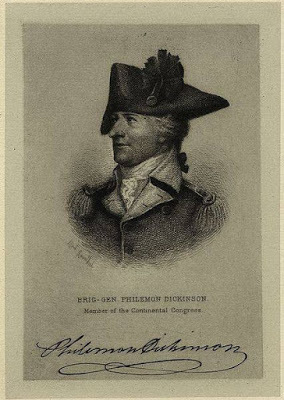 Philemon Dickinson
Philemon DickinsonThe Making of a Citizen
Philemon Dickinson was born at "Crosiadore”, in Talbot County, Maryland on 5 April 1739. The son of a local judge, Philemon was also the younger brother of fellow first-patriot and signer John Dickinson. Following his graduation from the College of Pennsylvania (now the University of Pennsylvania) in 1759 the younger Dickinson clerked briefly at his brother John’s law office. But Dickinson abandoned the profession shortly after and began to manage their father’s estates. In 1767 he married, Mary Cadwalader, member of one of the area's most prominent families. The couple moved to a farm just outside Trenton, New Jersey.
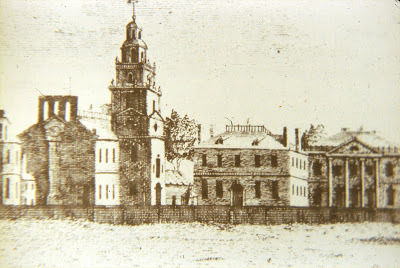 Dickinson attended the College of Pennsylvania
Dickinson attended the College of PennsylvaniaA Call to Arms
With a family caught up in revolutionary politics, it was natural that Philemon would eventually play a role along with big brother John. In 1775 he was offered a colonelcy in the Hunterdon County militia. This first patriot quickly accepted. By October the following year he had risen to the rank of brigadier general – he also held a seat in the state’s provincial congress. During the Continental Army’s retreat across the Jerseys in 1776, Dickinson proved a valuable asset to the beleaguered George Washington. Dickinson’s performance under fire at Trenton in December 1776 was most noteworthy. There the sturdy militia general ordered his own home shelled in the heat of battle after he learned it was an enemy command post!
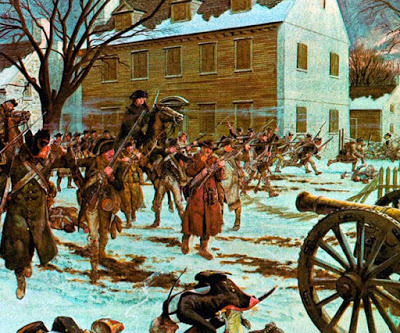 The American attack on Trenton
The American attack on TrentonKicking Off the Forage War
On 20 January 1777, Dickinson led a combined force of 350 Jersey militia men and 50 Pennsylvania riflemen in a bold strike against a British foraging party of some 500 Regulars and Hessians. Dickinson split his force into two wings. His determined band of men waded through the icy waist-deep Millstone River and surprised the enemy in a running gun battle that drove them back to their base at New Brunswick. Dickinson’s men captured three dozen supply wagons and over 100 horses. This was possibly Dickinson’s most noted single battle where he held overall command. The bold attack sent shock waves through the British command for, although they portrayed it as a successful rear guard action, it showed the militia was not going home for the winter. Instead, these citizen soldiers (and some Continental troops) eschewed home and hearth to pound an enemy desperate for “winter quarters.” The skirmish set the tone for a series of militia attacks, ambuscades and raids against the British attempts to forage in the Jerseys – the so-called forage war. That June, Dickinson was promoted to Major General and named commander in chief of the New Jersey militia.
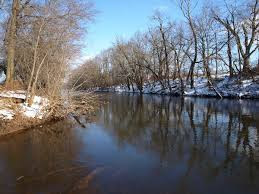 Jersey Militia and Pennsylvania Riflemen
Jersey Militia and Pennsylvania Riflemenwaded the icy Millstone River
Militia General
In May of 1778 he was tested as the New Jersey militia commander when his men fended off an attack on Trenton by British forces under Major John Maitland. The clash presaged the British “retrograde” from the occupied American capital. His mettle was soon tested once more. Washington dispatched him and his militia to disrupt and interdict the British column when the British commander, Sir Henry Clinton, ordered a retreat from Philadelphia. The bulk of the British Army had to march across the Jerseys to reach the safety of the highlands and the transports back to New York. Dickinson’s 800 men stayed ahead of the advancing column, felling trees and destroying bridges to slow its movement for Washington to attack it from the rear at the battle of Monmouth on 28 June.
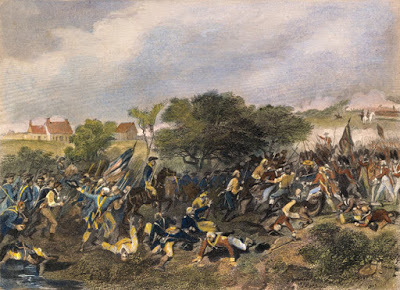 The Jersey militia slowed the retrograde of the British Army
The Jersey militia slowed the retrograde of the British Armyleading to the American attack at Monmouth
Crushing the Cabal
 John Cadwalader
John CadwaladerA staunch supporter of General Washington during one of the great military-political controversies of the war, the so-called Conway Cabal, Dickinson served as a second to his wife’s cousin, Pennsylvania General John Cadwalader. Cadwalader dueled with Franco-Irish General John Conway over the latter’s disparaging remarks against George Washington. In the 18th century’s dueling protocol, the Code Duello, the second played a key role in arranging, supporting, and sometimes partaking in the duel. Clearly, Dickinson proved a loyal family member as well as a bad ass supporter of his commander in chief. Cadwalader for his part won the duel - firing a pistol round into Conway’s mouth. The unlucky Conway survived and in a twist, professed loyalty to Washington before resigning from the Continental Army.
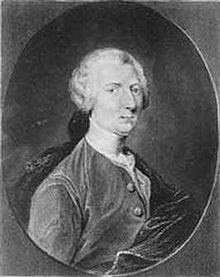 John Conway's opposition to Washington
John Conway's opposition to Washingtonled to a dual
War’s Last Gasp in the Jerseys
The course of the war would soon turn south but New Jersey’s proximity to New York made it a battleground of covert war and slashing small scale attacks. On 23 June 1780, the last battle in the north was fought at Springfield, New Jersey where Dickinson played a prominent role in repulsing the famed Hessian general Wilhelm von Knyphausen.
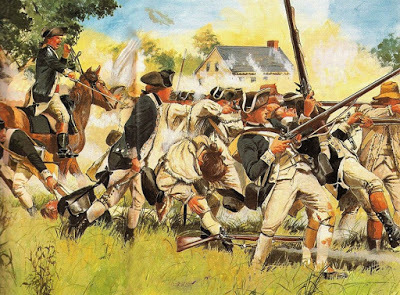 The Battle of Springfield
The Battle of SpringfieldSoldier to Citizen
Remarkably, but not unusually, Dickinson played a political role as well during his war years. With the action moving to the Southern theater, he turned to a less kinetic form of public service. He ran for governor of New Jersey three times, but lost them all. In 1782, however he became a member of the Continental Congress 1782-1783. Two years later he was vice president of the New Jersey state council. He served as a member of the commission to choose a site for the national capital in 1784. When factions broke out, the staunch Washington supporter turned to the Federalists. In 1790 he was selected to serve New Jersey as a US Senator, which he did until 1793. Mary had died in 1791 but typical for the age, Dickinson remarried.
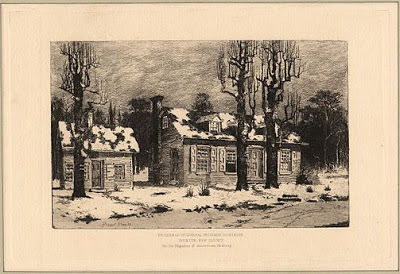 Dickinson retired to his estate
Dickinson retired to his estatenear Trenton
Ever the model citizen soldier, Philemon Dickinson eventually retired to his New Jersey estate “the Hermitage” outside Trenton in 1794. He died there on 4 February 1803 and was interred in the Friends Meeting House Burying Ground in Trenton.
Published on January 27, 2019 08:01
December 23, 2018
People: Johann Rall
A little known (to most) Hessian Colonel named Johann Gottlieb Rall played a critical role in the trajectory of the American War for Independence. Unfortunately for him, that trajectory included his defeat and death. But that should not diminish the life and service of this German military officer. An experienced Hessian officer, Rall is often portrayed as the hapless loser of the battle of Trenton. But he was much more than that. He was the archetypal professional German officer of the mid-18th century: skilled, with a self-assurance that came from experience.
Advancement
Johann Rall was born in the German principality of Hesse-Kassel in 1720. His father was a captain in the regiment Von Donop. At an early age the younger Rall joined as a cadet, then became a warrant officer and finally was commissioned a Second Lieutenant on August 28th, 1745. Within eight years he was a captain and, then promoted to Major on May 7th, 1760, under the command of Major General Bischhausen. In January, 1763, he was transferred to the garrison at Stein, where he was appointed Lieutenant Colonel.
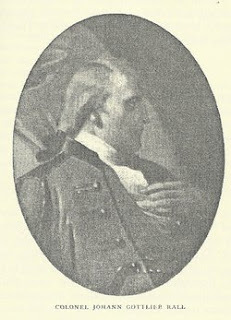
On April 22, 1771, now a Colonel, he took command of the Mansbach Infantry Regiment, a storied unit. Unlike the British army of the era, officers were promoted on a merit basis, and not by purchase of birth right. Along the way to his colonelcy, Rall would have served as platoon leader, company commander (perhaps more than once) and as a staff officer, likely adjutant. So at age 51, he was a highly experienced and professional military officer. Perhaps among the best of his age.
Early Service
So where did Johann Rall serve to reach the lofty heights of regimental command? Actually, Rall's service is a virtual taxonomy of the wars of the mid-18th century. He fought in the War of the Austrian Succession - serving in campaigns from the low lands of Flanders, on the Rhineland and in Bavaria.
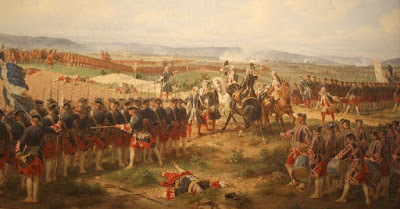 A youthful Rall fought in the War of Austrian Succession
A youthful Rall fought in the War of Austrian SuccessionHe even served in Scotland during the Jacobite rising of 1745 – not his last service to the German kings of England. Here Rall was part of a contingent of some six thousand Hessian troops under the command of their prince, the Elector, Frederick II, Landgrave of Hesse-Kassel. Frederick deployed his forces in support of his father in law, George II of England.
 The battle of Culloden ended the Jacobite Rising
The battle of Culloden ended the Jacobite RisingOf course Rall was there when the big one broke out. Like pretty much all European professional soldiers, he saw action in numerous battles during the Seven Years' War (America’s French and Indian War) . This global conflict was fought between 1756 and 1763, and involved every European great power. It spanned five continents, affecting Europe, the Americas, West Africa, India, and the Philippines. The conflict involved two major coalitions, one led by the Great Britain (along with Prussia, Portugal, Hanover, and other small German states such as Hesse-Kassel), the other led by the France (with allies Austria, the Russian, Spain, and Sweden).
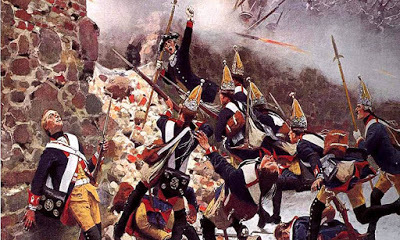 Storming a village in the seven Years War
Storming a village in the seven Years WarMost of the professional armies of Europe had an interlude of peace after the The Treaty of Paris of 1763 ended the French and Indian War/Seven Years' War. But Rall managed to stay busy in his chosen profession. From September 1771 until August 1772, he fought for Russia’s Catherine the Great under Count Orlov in the Russo-Turkish War.
 The Russo-Turkish War of 1771 was one of many
The Russo-Turkish War of 1771 was one of manyfought between the two empires
Coming to Amerika
What makes Johann Gottlieb Rall interesting to the Yankee Doodle Spies is his role as a Hessian officer in His Majesty’s service during the American War for Independence. Upon his return to Germany, Rall received command of a grenadier regiment that bore his name. In 1775, Landgrave Frederick Wilhelm II offered to “rent” several of his professional regiments to the King of England. It is said he used the revenues from such ventures to pay for his patronage of the arts. I guess it was blood for beauty. And so Rall and the regiment bearing his name embarked for America with a division of German troops under General Wilhelm von Knyphausen.
Knyphaussen’s forces were part of British Major General William Howe’s army that invaded Staten Island, Long Island, New York (Manhattan), Westchester, and the Jerseys. in 1776. Rall was noted for his performance under fire on Long Island and again at Fort Washington, where Knyphausen’s Hessians distinguished themselves with audacity, skill and courage.
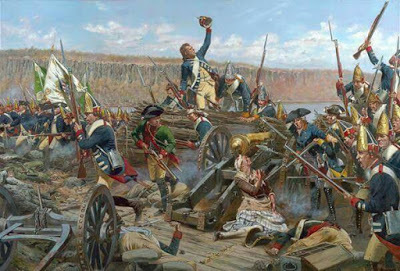 Rall's Grenadiers storm a redoubt at Fort Washington
Rall's Grenadiers storm a redoubt at Fort WashingtonAt Fort Washington, Rall led the final assault from the front. One of his men, Private Johann Reuber, recalled him encouraging the grenadiers, "All that are my grenadiers, march forward." Leading the charge, Rall’s grenadiers captured their objective. His grenadiers lost 177 men in the action, a large number of casualties for the period and a tribute to their courage and audacity - as well as Yankee marksmanship.
These battles were mostly, although not always, against raw, undisciplined and poorly supplied troops. It did not take long for the Hessians and Rall himself, to hold die Rebellen in contempt. In fact, most of the Hessian officers became perplexed that Howe did not strike the "rabble" more aggressively and destroy them. Howe’s ponderous style of warfare did not sit well with the smash mouth approach of the crack German troops and their leaders.
Blitzkrieg turns to Winter Quarters
As General George Washington led his defeated army across the cold and snowy Jerseys in December 1776, it looked like the war was about up. The Germans, along with many of the British officers, felt it was just a matter of days before they would have Washington crushed and the rebel capital taken. To their dismay, Howe decided he had done enough for the year. He put the army into winter quarters with the smug expectation that he would have a cake walk to Philadelphia in the spring. After all, the rebels had been chased across the Delaware with their tails between their legs and the morale of the American populace was at nadir. He was right, too. Except for one small problem, General Washington was not in winter quarters.
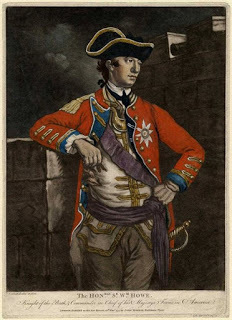 Gen William Howe put his
Gen William Howe put hisarmy into winter quarters a bit too early
Howe compounded his mistake by spreading his forces in small garrisons across West Jersey. From Perth Amboy, New Brunswick, Princeton, Trenton and Bordentown. The weather, and the appetizingly small, brigade-size garrisons gave the beleaguered American commander the opportunity he needed. He would strike the closest garrisons: Bordentown and Trenton. Bordentown proved a missed opportunity but Trenton did not.
The some sixteen hundred Hessians that made up Trenton’s garrison had been under pressure. The Jersey militia had rallied against them. Couriers, patrols and foraging efforts were attacked. Rall’s officers recommended they fortify Trenton. The town had a comfortable barracks that the troops occupied but other than an isolated block house north of the town, they had nothing. Professional though Rall was, his contempt for the Americans was telling. He dismissed the suggestions as unnecessary. Rall in fact stated he dared the Americans to attack so he could crush them. This was not mere hubris, but a cold, professional calculation. It would, however, prove a bad one.
 The Trenton garrison had some of the best infantry
The Trenton garrison had some of the best infantryin any army of its day
Rall also dismissed the engineer officer sent to assist with the defenses. He simply felt his men would overwhelm any rebel force that came near Trenton. Rall claimed he could be attacked from all sides and would defends from all sides. No redoubts were needed. But he did increase patrols, leading some of them himself.
As Christmas approached, British intelligence had received word from a spy that the Americans might be preparing an attack on Trenton. The British commander in the Jerseys, General James Grant himself was skeptical of a rebel attack. But he sent a note to Rall to warn him anyway. Rall scoffed at the notion and dismissed the idea as alarmist. Besides, he had complete faith and trust in the professionalism of his men, and incompetence of the enemy. The former is usually a good thing, the latter not so good. Rall stuffed the note in his pocket.
 Washington launches his gambit on Christmas
Washington launches his gambit on ChristmasHeilege Nacht
Now, in the German world Christmas eve is a very big deal. Bigger than Christmas day. How much “celebrating” took place is subject to some speculation. Likely some did. But the real problem the Hessians faced was the weather, the Jersey militia, and frankly, some fatigue. The campaign had been long.
Rall spent Christmas eve at the Stacey Potts house in Trenton. Unbeknownst to him, his officer of the day, Major Friedrich von Dechow, cancelled the next morning’s dawn patrol due to the bad weather. Other officers ordered their troops in outposts to shelter in place as the weather came in in. It was, as they say, a perfect storm. Washington struck Trenton in a surprise early morning attack on Christmas Day 1776. Washington’s 2400 men outnumbered the 1600 hundred defenders. But numbers were not the decisive factor, surprise was.
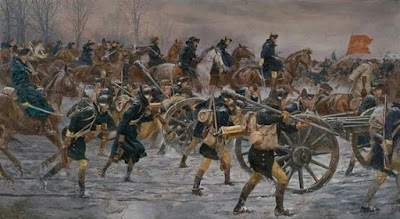 The Americans depended on the cover of dark
The Americans depended on the cover of dark and bad weather to fuel their surprise
The Element of Surprise
Just after sunrise, one of the Hessian officers sheltering near the outskirts of Trenton, Lieutenant Andreas von Wiederholdt, stepped out the building he had sheltered in and was surprised to see rebels emerging from the woods around the town. He rallied his platoon and exchanged fire with the oncoming troops, but was quickly overwhelmed. By time the alarm was finally sounded,Trenton was already surrounded on three sides.
Artillery rounds from Henry Knox’s battery began to pound the town. The Americans had occupied several houses and as the infantry tried to rally they picked them off. In the wet snow, return fire by the Hessians was difficult with wet powder and flints.
 Knox's Artillery suppressed the Hessian attempt to
Knox's Artillery suppressed the Hessian attempt tocounter attack
Surprised, outnumbered, surrounded, and overwhelmed by firepower – the situation for the defenders was bleak. But the Hessian discipline was not gone. What you do in training you will do in combat. And the Hessians were well trained. Drummers were soon beating away and Rall’s regiment rallied. Officers signaled for ranks to form. Sergeants and corporals got the men into ranks. Some were in partial sate of dress or without all their equipment. But they formed.
 Washington's pincer movement almost bagged the entire garrison
Washington's pincer movement almost bagged the entire garrisonCommands were shouted over the crack of musket shots. But confusion began to turn to order when Rall appeared. He looked tired, some say in his cups, but this is unproven. Rall struggled to mount his horse and rally the troops for a charge that would disperse the rebels like so much chaff from a scythe. That is how they always did it. They would do it again.
As at Fort Washington, Rall called on his grenadiers to advance with him. This they did and two of the three regiments formed ranks and advanced with colors flying and drums beating. They would disperse the rebels yet. But this was a different army. Well led and motivated. More importantly, the advancing formation was enfiladed from three sides by Continental infantry firing from the cover of houses and artillery bombarding them from the flank. The wet snow prevented much return fire and cold steel would not be enough this day. Still, they were advancing on the enemy. "Nach Vorne!"
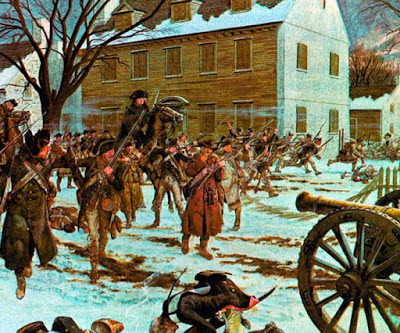 The American infantry surpassed the crack Hessian regulars
The American infantry surpassed the crack Hessian regularsAt that critical moment, a musket ball struck Rall in the side. He jerked, but managed to turn his horse around and tried raise his saber. Then a second round struck him. Rall went down, mortally wounded. Seeing their commander shot from his horse, the usually steadfast Hessian infantry retreated into an orchard and attempted to form up once more. Rall was carried to a nearby church and finally back to the house of Stacey Potts. He died there that night.
 Rall was stuck down at the critical moment
Rall was stuck down at the critical momentDetermined, Washington had his men pour fire into their ranks while Knox’s guns cut through them with round shot. Men were falling. Having just seen their beloved commander carried off, morale was quickly ebbing. At first, the Hessians refused calls to surrender. Washington was preparing to order Henry Knox to switch canister – this would have torn through the Hessian ranks like a 12 gauge rounds through a flock of fat geese. But the grim work was not to be. Ever professional, the Hessians realized it was over and began to ground arms in surrender. Other than a few hundred who fled across the Assenpunk River, the Trenton garrison was captured by the ragged rebel forces led by General George Washington.
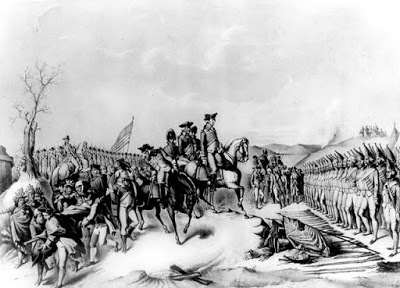 After he was struck down,
After he was struck down,Rall's men forced to surrender to die Rebellen
What of Rall?
So was Johann Gottlieb Rall an arrogant Teuton and drunk, whose hubris cost him his command, his life, and most importantly, his reputation? As is usually the case, the verdict is mixed. Rall was well respected by his men. In an army when blind obedience to officers and NCOs was demanded, respect was not. And he had their respect. Even more remarkable, Rall was liked by his men.
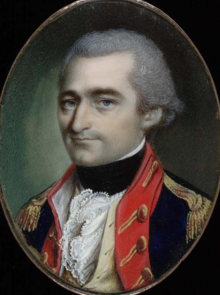 Rall in better times
Rall in better timesA noted diarist of the war and adjutant to Rall at Trenton, Lieutenant Jakob Piel writes, “Considered as a private individual, he merited the highest respect. He was generous, magnanimous, hospitable, and polite to everyone; never groveling before his superiors, but indulgent with his subordinates. To his servants he was more a friend than master. He was an exceptional friend of music and a pleasant companion."
Note that Rall was outspoken with his superiors. Few had his combat experience. The brutally frank Rall let them know it. Fellow Hessian, Colonel Carl von Donop treated Rall with contempt. But Captain Johann Ewald of the Jaegers, who later rose to the rank of Lieutenant General claimed that, when it came to fighting, none of the other German officers were fit to carry Rall’s sword.
British Colonel William Faucitt considered Rall, “... one of the best officers of his rank in the Landgrave’s Army."

Goat? Or Scapegoat?
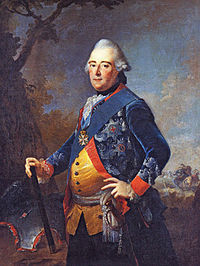 Friederich Wilhelm II - not
Friederich Wilhelm II - notpleasedRall’s ruler and commander in chief, Prince Frederick Wilhelm II convened a court martial to determine what had happened to his proud army at Trenton. Bad for business if the Hessians were seen as easy marks for undisciplined troops. Predictably, the court blamed the defeat on Rall and four of his officers. Since they were now dead there was no real defense made. Colonel Rall was found "guilty" of not fortifying Trenton. But the truth is, fortifications would have been of little help as most of the men were sheltering from the weather. And the Americans had superiority in artillery. Not surprisingly, all the surviving Hessian officers were conveniently cleared of wrong doing. Of course, a Hessian court could not address the larger factors in the defeat: Howe’s dispersal of small garrisons in a hostile region. Grant’s inability to support the forward garrisons, who were under constant rebel militia pressure. Colonel Johann Gottlieb Rall was not inculpable of course – but he took the hit for the whole thing.
Yankee Doodle Postscript
Actually, a shameless Yankee Doodle Spies plug - my second novel in the famed Revolutionary War espionage series concludes with all the events surrounding the campaign that led to and the battle of Trenton. I take some liberties with dialogue and certain scenes but none with the actual events of history. I believe I captured Rall pretty well as part of the mix.
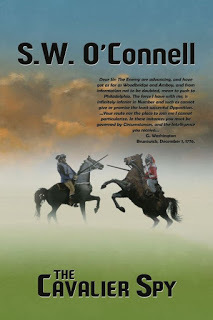
Published on December 23, 2018 13:53
November 11, 2018
Things: The Prediction
The French Connection
Most know that Marie-Joseph Paul Yves Roch Gilbert du Motier, Marquis de Lafayette, known in the United States simply as Lafayette, was a 19 year old French aristocrat and military officer who fought in the American Revolutionary War, commanding American troops in several battles, including the Siege of Yorktown.
 Lafayette leading troops at Yorktown
Lafayette leading troops at YorktownReform, Revolution & Chaos in France
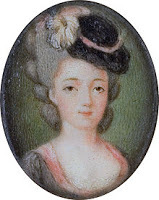 Marie Adrienne Francoise de Noailles,
Marie Adrienne Francoise de Noailles,Lafayette's wifeThe young general and confidant of General George Washington later returned to France where he played a key and tragic role in his own nation's revolution. Lafayette led the original reform movement and stayed the course hoping to be a moderate influence as the French veered left and violence entered the body politic. He led the National Guard and the French Army when his Patrie was invaded. Eventually the Marquis and his family were caught up in the reign of terror in Paris in 1792. Accused of treason, Lafayette escaped to the Austrian Netherlands (Belgium), where he was captured by Austrian troops and spent more than five years in prison. Meanwhile, his wife Adrienne was imprisoned in Paris, a prisoner of the revolution's Committee of Public Safety. There she and her daughter waited in fear as the reign of terror was sending thousands of her fellow nobles (and others) to the guillotine. In fact, Adrienne’s mother, grandmother, and sister were all executed during the bloodbath in the name of Liberte, Egalite & Fraternite.
 The reign of terror stained the revolutionary cause and the streets of Paris
The reign of terror stained the revolutionary cause and the streets of Paris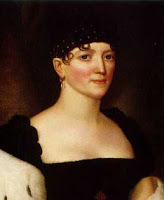 Elizabeth Monroe
Elizabeth Monroefuture First LadyFortunately, in 1794, his former comrade in arms (and future American president)James Monroe had become American Minister to France. Monroe and his wife Elizabeth arranged a carriage in which Elizabeth rode to the prison and managed to meet and embrace Adrienne in view of a crowd of Parisians. The emotion of the event forced the Committee of Public Safety to grant Adrienne’s freedom, and she and her daughter traveled to Austria to be with Lafayette. He remained there under dire circumstances until Napoleon Bonaparte forced his release in 1797. But when he returned to France Lafayette refused to support Napoleon's government. He lived as a private citizen until the restoration government where he served as a member of the Chamber of Deputies. In 1807 Adrienne died of illness on Christmas eve.
The Return of Lafayette
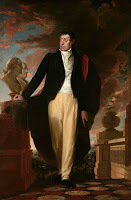 Samuel Morse
Samuel Morse (telegraph inventor)
portrait of Lafayette By 1824 Lafayette was the last surviving French general of the American Revolutionary War. As he approached his own "evening parade" he made a tour of the 24 states in the United States from July 1824 to September 1825. This was his first return trip since the American Revolution.The former Continental Army general was received by the populace with a hero's welcome at many stops, and many honors and monuments were presented to commemorate and memorialize the visit. On New Year’s Day in 1825, Congress gave Lafayette a dinner to honor the hero. At the event, Lafayette returned the kind words and gestures of his American hosts with a toast that presaged the future: “The perpetual union of the United States: It has always saved us in time of storm; one day it will save the World.” He might have added, "and France twice..."
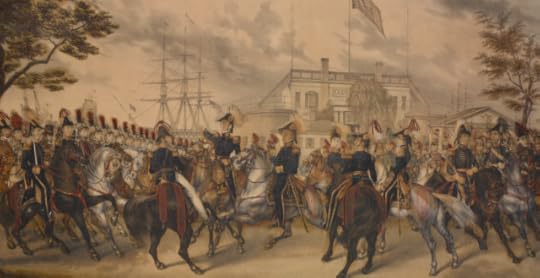 NYC parade honoring Lafayette was one of many across the new nation
NYC parade honoring Lafayette was one of many across the new nationWe are Here
Almost a century after the Marquis toasted the power of the nation he helped to birth, Charles E. Stanton, the nephew of Lincoln's Secretary of War, Edwin Stanton, took the Marquis's vision seriously. Stanton, a career Army officer, arrived in France as an aide to General John J. Pershing during World War I. They were on a close hold mission to begin planning for the arrival and training of the American Expeditionary Force. After three years of watching from the sidelines America declared war on the German empire and its allies.
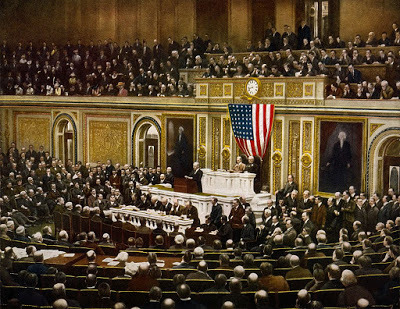 President Wilson asked Congress to declare war on Imperial Germany
President Wilson asked Congress to declare war on Imperial Germanyin April 1917
On July 4, 1917, Stanton, as part of John J. Pershing's staff visited the tomb of La Lafayette and said, "Lafayette, we are here!" to honor the nobleman's assistance during the Revolutionary War and assure the French people that the people of the United States would aid them in World War I. Stanton’s remarks were originally attributed to Pershing because the press was under a strict censor policy not to print the name and location of any U.S. soldier in Europe, with the only exception, General Pershing.
 Charles Stanton is third from left in photo
Charles Stanton is third from left in photoPershing is forefront facing
The Prediction
Lafayette's toast predicting his adopted land's saving the world is more than a polite tip of the hat. By the early 19th century, the growth and potential power of the new nation was widely accepted. And Lafayette's devotion to the country's basic goodness, combined with its potential gave him every reason to make the leap with such a bold statement. As it turned out, his faith in his adopted country was more than a good bet.
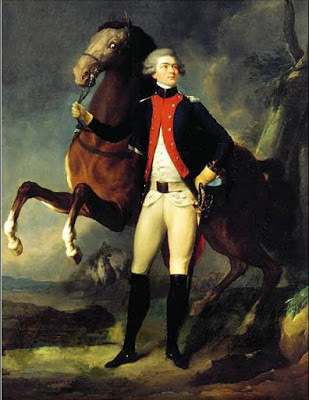 Lafayette
Lafayette
Published on November 11, 2018 07:09
October 28, 2018
Things: Chatterton Hill
A War of Maneuver
The campaign of conquest in New York was one of maneuver on land and sea. During the late summer of 1776, the British landed on Long Island and forced the Continental Army back to the Island of New York (Manhattan), where they faced a stalemate at Harlem Heights.
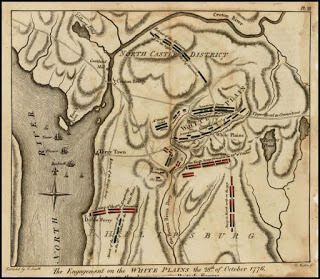
After the fighting at Harlem Heights, General George Washington’s Continental Army continued to hold on to upper Manhattan. By mid-October, Washington learned that the British were again on the move, planning to land in what is now Westchester County and surround him. Washington moved most of his forces across the Kings Bridge, leaving a garrison of some 1,500 under General Nathanael Greene to hold Fort Washington. The British landed at Pell’s Point and there began a cat and mouse game as the British advance was slowed by a series of holding actions by valiant American riflemen. Eventually Washington determined on a stand against the British, who were pushing west towards the North (Hudson) River that would cut Washington off from his supply line. He established a defensive position in the hills of White Plains, where the terrain might favor a defensive stand. The armies were about evenly matched, although Washington’s force of 14,500 men were in no way as well trained or equipped as Howe’s force of 13,00 British regulars and Hessian professionals.
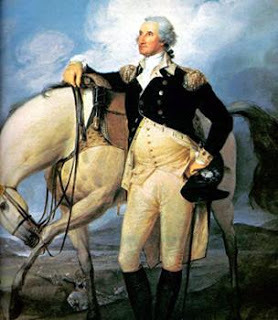 Gen George Washington's initial overlook
Gen George Washington's initial overlook
of Chatterton Hill gave the British an opportunity
A Place of Battle
Present-day White Plains offers few reminders of the American Revolution. In this Westchester County suburb of New York, office buildings and a bustling downtown are surrounded by residential neighborhoods. It was in White Plains that the youthful version of your author took the road test for his driver’s license. At the time, I, like the thousands who live and work in the city, had no idea that nearby was once a bitterly contested battlefield.
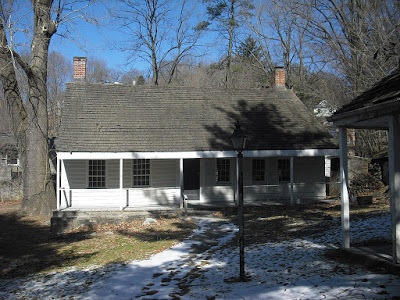 Washington 's HQ wasat the Elijah Miller House in North White Plains
Washington 's HQ wasat the Elijah Miller House in North White Plains
Washington Decides to Stand His Ground
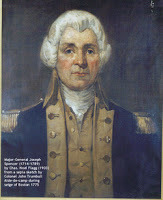 Col Joseph SpencerBy October 28 1776, Washington’s forces occupied a crescent shaped three-mile line between the Bronx River to the east and the Crotton River to the west. Washington established his headquarters at the Elijah Miller House in North White Plains and chose a defensive position that he fortified with two lines of entrenchments. The trenches were dug on raised terrain, their right flank protected by the swamps near the Bronx River, and steep hills further back as a place of retreat. Divisions under Israel Putnam, William Heath are placed on the right and left flanks. Washington himself held the center. Beyond the right flank of this defensive line lay Chatterton Hill, which dominated the ground over which the British would have to advance. Curiously, Washington initially had posted only some militia companies under Connecticut Colonel Joseph Spencer to guard this obvious piece of key terrain. He would soon have to send more.
Col Joseph SpencerBy October 28 1776, Washington’s forces occupied a crescent shaped three-mile line between the Bronx River to the east and the Crotton River to the west. Washington established his headquarters at the Elijah Miller House in North White Plains and chose a defensive position that he fortified with two lines of entrenchments. The trenches were dug on raised terrain, their right flank protected by the swamps near the Bronx River, and steep hills further back as a place of retreat. Divisions under Israel Putnam, William Heath are placed on the right and left flanks. Washington himself held the center. Beyond the right flank of this defensive line lay Chatterton Hill, which dominated the ground over which the British would have to advance. Curiously, Washington initially had posted only some militia companies under Connecticut Colonel Joseph Spencer to guard this obvious piece of key terrain. He would soon have to send more.
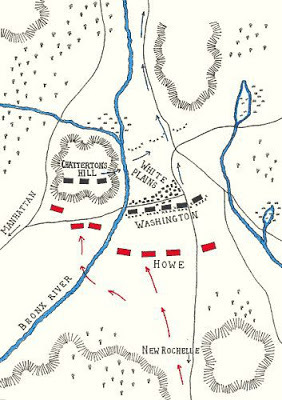 White Plains
White Plains
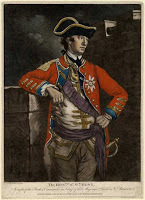 Sir William HoweAround mid-morning, word reached Washington of the British approaching in two columns along the East Chester Road. When they arrived, the British army deployed in an open area about one mile in front of the American line where their array was quite visible to the defenders. Was this an attempt at intimidation by the British commander, Sir William Howe to subvert American morale? Who knows what the delay cost him real terms. Could another Bunker Hill be in the offing? This was always Howe’s fear since he played a key role in Britain’s Pyrrhic victory outside Boston. That coupled with his hope of reconciliation with the rebels seemed to hold him back from a massive attack that could cost both sides.
Sir William HoweAround mid-morning, word reached Washington of the British approaching in two columns along the East Chester Road. When they arrived, the British army deployed in an open area about one mile in front of the American line where their array was quite visible to the defenders. Was this an attempt at intimidation by the British commander, Sir William Howe to subvert American morale? Who knows what the delay cost him real terms. Could another Bunker Hill be in the offing? This was always Howe’s fear since he played a key role in Britain’s Pyrrhic victory outside Boston. That coupled with his hope of reconciliation with the rebels seemed to hold him back from a massive attack that could cost both sides.
Seize the Good Ground
This time Howe made a series of good decisions. He scanned the American defenses to his front. He realized he had the manpower and firepower to make a frontal assault. But Howe quickly recognizes there is another way - a way to move Washington without a blood bath. The lightly defended high ground known as Chatterton Hill over on Washington’s right is the key to the battlefield. Seize that and the Americans are bagged! Howe conferred with his staff and decided the main attack would go against Chatterton Hill while the rest of the army kept the main American line occupied. He began preparations to storm the hill, giving the attack to General Alexander Leslie (See the Yankee Doodle Spies blog on Leslie), with two British infantry regiments supported by a force of Hessians. Soon a bloody if inconclusive fight would ensue.
 View of White Plains from Chatterton Hill
View of White Plains from Chatterton Hill
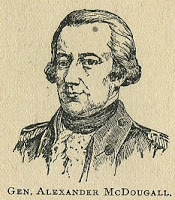 At last, Washington realized the danger he faced if the British seized the key terrain. He rushed to reinforce the heights with another 2,000 men under Colonel Joseph Reed. The critical outpost on Chatterton Hill eventually would be held by some 4,000 men under the overall command of Colonel Alexander McDougall. His force would include two New England militia regiments under Colonel Rufus Putnam and Spencer's men. Even as Howe and his staff conferred, his Hessian artillery opened fire on the hilltop. A force of 1500 skirmishers under Colonel Joseph Spencer is arrayed along the front. The American defenses seemed sound. But when the British finally launch their attack, they quickly brushed aside the skirmishers, who scattered before the attackers. But the arrival of McDougall and his brigade helped to rally them, and a defensive line was established, with the militia on the right and the Continentals arrayed along the top of the hill.
At last, Washington realized the danger he faced if the British seized the key terrain. He rushed to reinforce the heights with another 2,000 men under Colonel Joseph Reed. The critical outpost on Chatterton Hill eventually would be held by some 4,000 men under the overall command of Colonel Alexander McDougall. His force would include two New England militia regiments under Colonel Rufus Putnam and Spencer's men. Even as Howe and his staff conferred, his Hessian artillery opened fire on the hilltop. A force of 1500 skirmishers under Colonel Joseph Spencer is arrayed along the front. The American defenses seemed sound. But when the British finally launch their attack, they quickly brushed aside the skirmishers, who scattered before the attackers. But the arrival of McDougall and his brigade helped to rally them, and a defensive line was established, with the militia on the right and the Continentals arrayed along the top of the hill.
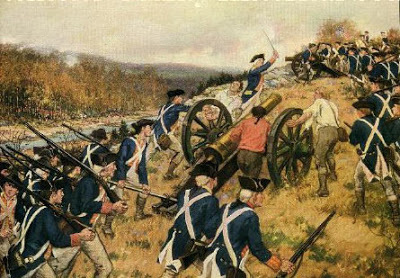 Washington rushes reinforcements to the heights
Washington rushes reinforcements to the heights
Although he now faced a well-orchestrated onslaught, McDougall made a game defense of it. He managed to pin Leslie’s column at the ford, repulsing several attempts to cross the Bronx River. In response, Howe ordered up more men while a force of Hessian infantry under Colonel Johann Rall, supported by British dragoons, moved on the American right flank. The Hessians manage to ford the river and charge up the steep slope, but the desperate and well positioned Americans drove them back. Not to be outdone by die Rebellen, Rall rallied his men and organized a second attack with more firepower. The artillery fired up the Americans defending the crest of the hill, which sent the militia troops to run. But despite the intense barrage the Continentals stubbornly held on until the Hessians finally turned their right flank, forcing them back as well.
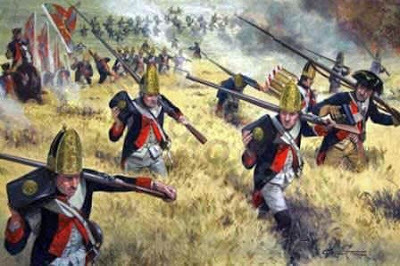 Hessians advancing under fireA Timely Retreat, An Untimely Pause
Hessians advancing under fireA Timely Retreat, An Untimely Pause
With his flank exposed and crumbling, Washington ordered a retreat and the Americans withdraw from the hill. Unfortunately for the British, William Howe stays true to form and does not follow up his success with a vigorous pursuit that might have destroyed the Continental Army and ended the war. Instead, he awaits reinforcements from the rest of his army and simply bivouacs his men on Chatterton Hill. This gave Washington time to move his army to stronger positions at nearby North Castle a few days later. Although the Americans lost the Chatterton heights along with some one hundred thirty killed and wounded, taking the heights cost Howe some two hundred fifty irreplaceable British and Hessian troops killed and wounded. In a sense, Howe came out ahead in that Washington ultimately evacuated New York and abandoned the defenders of Fort Washington to their ultimate demise. But the war of posts would now morph into a war of maneuver, this time across the Jerseys.
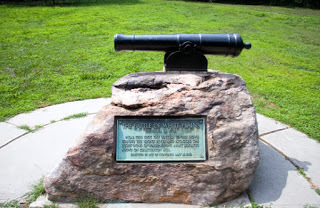
A Halloween Connection?
Little remembered in history, the action at Chatterton Hill has a connection to American lore and the eerie celebration of Halloween. Washington Irving’s story, The Legend of Sleepy Hollow, and the film, Sleepy Hollow, are centered on the haunting by a “Headless Hessian Horseman.” By some accounts Irving based the story on an incident during the Battle of White Plains when a Hessian soldier, decapitated by a cannon shot on Chatterton Hill, roams the Westchester night seeking vengeance. so Chatterton Hill leaves a legacy of little military importance but an eerie contribution to American folklore… oh yes, and your humble author passed his road test - first time.
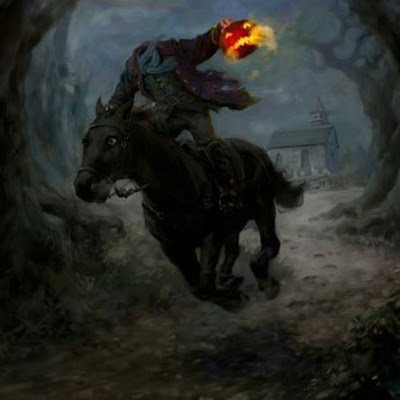 A Hessian's death at Chatteron Hill may have inspired
A Hessian's death at Chatteron Hill may have inspired
one of America's earliest legends - Sleepy Hollow
The campaign of conquest in New York was one of maneuver on land and sea. During the late summer of 1776, the British landed on Long Island and forced the Continental Army back to the Island of New York (Manhattan), where they faced a stalemate at Harlem Heights.

After the fighting at Harlem Heights, General George Washington’s Continental Army continued to hold on to upper Manhattan. By mid-October, Washington learned that the British were again on the move, planning to land in what is now Westchester County and surround him. Washington moved most of his forces across the Kings Bridge, leaving a garrison of some 1,500 under General Nathanael Greene to hold Fort Washington. The British landed at Pell’s Point and there began a cat and mouse game as the British advance was slowed by a series of holding actions by valiant American riflemen. Eventually Washington determined on a stand against the British, who were pushing west towards the North (Hudson) River that would cut Washington off from his supply line. He established a defensive position in the hills of White Plains, where the terrain might favor a defensive stand. The armies were about evenly matched, although Washington’s force of 14,500 men were in no way as well trained or equipped as Howe’s force of 13,00 British regulars and Hessian professionals.
 Gen George Washington's initial overlook
Gen George Washington's initial overlook of Chatterton Hill gave the British an opportunity
A Place of Battle
Present-day White Plains offers few reminders of the American Revolution. In this Westchester County suburb of New York, office buildings and a bustling downtown are surrounded by residential neighborhoods. It was in White Plains that the youthful version of your author took the road test for his driver’s license. At the time, I, like the thousands who live and work in the city, had no idea that nearby was once a bitterly contested battlefield.
 Washington 's HQ wasat the Elijah Miller House in North White Plains
Washington 's HQ wasat the Elijah Miller House in North White PlainsWashington Decides to Stand His Ground
 Col Joseph SpencerBy October 28 1776, Washington’s forces occupied a crescent shaped three-mile line between the Bronx River to the east and the Crotton River to the west. Washington established his headquarters at the Elijah Miller House in North White Plains and chose a defensive position that he fortified with two lines of entrenchments. The trenches were dug on raised terrain, their right flank protected by the swamps near the Bronx River, and steep hills further back as a place of retreat. Divisions under Israel Putnam, William Heath are placed on the right and left flanks. Washington himself held the center. Beyond the right flank of this defensive line lay Chatterton Hill, which dominated the ground over which the British would have to advance. Curiously, Washington initially had posted only some militia companies under Connecticut Colonel Joseph Spencer to guard this obvious piece of key terrain. He would soon have to send more.
Col Joseph SpencerBy October 28 1776, Washington’s forces occupied a crescent shaped three-mile line between the Bronx River to the east and the Crotton River to the west. Washington established his headquarters at the Elijah Miller House in North White Plains and chose a defensive position that he fortified with two lines of entrenchments. The trenches were dug on raised terrain, their right flank protected by the swamps near the Bronx River, and steep hills further back as a place of retreat. Divisions under Israel Putnam, William Heath are placed on the right and left flanks. Washington himself held the center. Beyond the right flank of this defensive line lay Chatterton Hill, which dominated the ground over which the British would have to advance. Curiously, Washington initially had posted only some militia companies under Connecticut Colonel Joseph Spencer to guard this obvious piece of key terrain. He would soon have to send more. White Plains
White Plains Sir William HoweAround mid-morning, word reached Washington of the British approaching in two columns along the East Chester Road. When they arrived, the British army deployed in an open area about one mile in front of the American line where their array was quite visible to the defenders. Was this an attempt at intimidation by the British commander, Sir William Howe to subvert American morale? Who knows what the delay cost him real terms. Could another Bunker Hill be in the offing? This was always Howe’s fear since he played a key role in Britain’s Pyrrhic victory outside Boston. That coupled with his hope of reconciliation with the rebels seemed to hold him back from a massive attack that could cost both sides.
Sir William HoweAround mid-morning, word reached Washington of the British approaching in two columns along the East Chester Road. When they arrived, the British army deployed in an open area about one mile in front of the American line where their array was quite visible to the defenders. Was this an attempt at intimidation by the British commander, Sir William Howe to subvert American morale? Who knows what the delay cost him real terms. Could another Bunker Hill be in the offing? This was always Howe’s fear since he played a key role in Britain’s Pyrrhic victory outside Boston. That coupled with his hope of reconciliation with the rebels seemed to hold him back from a massive attack that could cost both sides.Seize the Good Ground
This time Howe made a series of good decisions. He scanned the American defenses to his front. He realized he had the manpower and firepower to make a frontal assault. But Howe quickly recognizes there is another way - a way to move Washington without a blood bath. The lightly defended high ground known as Chatterton Hill over on Washington’s right is the key to the battlefield. Seize that and the Americans are bagged! Howe conferred with his staff and decided the main attack would go against Chatterton Hill while the rest of the army kept the main American line occupied. He began preparations to storm the hill, giving the attack to General Alexander Leslie (See the Yankee Doodle Spies blog on Leslie), with two British infantry regiments supported by a force of Hessians. Soon a bloody if inconclusive fight would ensue.
 View of White Plains from Chatterton Hill
View of White Plains from Chatterton Hill At last, Washington realized the danger he faced if the British seized the key terrain. He rushed to reinforce the heights with another 2,000 men under Colonel Joseph Reed. The critical outpost on Chatterton Hill eventually would be held by some 4,000 men under the overall command of Colonel Alexander McDougall. His force would include two New England militia regiments under Colonel Rufus Putnam and Spencer's men. Even as Howe and his staff conferred, his Hessian artillery opened fire on the hilltop. A force of 1500 skirmishers under Colonel Joseph Spencer is arrayed along the front. The American defenses seemed sound. But when the British finally launch their attack, they quickly brushed aside the skirmishers, who scattered before the attackers. But the arrival of McDougall and his brigade helped to rally them, and a defensive line was established, with the militia on the right and the Continentals arrayed along the top of the hill.
At last, Washington realized the danger he faced if the British seized the key terrain. He rushed to reinforce the heights with another 2,000 men under Colonel Joseph Reed. The critical outpost on Chatterton Hill eventually would be held by some 4,000 men under the overall command of Colonel Alexander McDougall. His force would include two New England militia regiments under Colonel Rufus Putnam and Spencer's men. Even as Howe and his staff conferred, his Hessian artillery opened fire on the hilltop. A force of 1500 skirmishers under Colonel Joseph Spencer is arrayed along the front. The American defenses seemed sound. But when the British finally launch their attack, they quickly brushed aside the skirmishers, who scattered before the attackers. But the arrival of McDougall and his brigade helped to rally them, and a defensive line was established, with the militia on the right and the Continentals arrayed along the top of the hill. Washington rushes reinforcements to the heights
Washington rushes reinforcements to the heightsAlthough he now faced a well-orchestrated onslaught, McDougall made a game defense of it. He managed to pin Leslie’s column at the ford, repulsing several attempts to cross the Bronx River. In response, Howe ordered up more men while a force of Hessian infantry under Colonel Johann Rall, supported by British dragoons, moved on the American right flank. The Hessians manage to ford the river and charge up the steep slope, but the desperate and well positioned Americans drove them back. Not to be outdone by die Rebellen, Rall rallied his men and organized a second attack with more firepower. The artillery fired up the Americans defending the crest of the hill, which sent the militia troops to run. But despite the intense barrage the Continentals stubbornly held on until the Hessians finally turned their right flank, forcing them back as well.
 Hessians advancing under fireA Timely Retreat, An Untimely Pause
Hessians advancing under fireA Timely Retreat, An Untimely PauseWith his flank exposed and crumbling, Washington ordered a retreat and the Americans withdraw from the hill. Unfortunately for the British, William Howe stays true to form and does not follow up his success with a vigorous pursuit that might have destroyed the Continental Army and ended the war. Instead, he awaits reinforcements from the rest of his army and simply bivouacs his men on Chatterton Hill. This gave Washington time to move his army to stronger positions at nearby North Castle a few days later. Although the Americans lost the Chatterton heights along with some one hundred thirty killed and wounded, taking the heights cost Howe some two hundred fifty irreplaceable British and Hessian troops killed and wounded. In a sense, Howe came out ahead in that Washington ultimately evacuated New York and abandoned the defenders of Fort Washington to their ultimate demise. But the war of posts would now morph into a war of maneuver, this time across the Jerseys.

A Halloween Connection?
Little remembered in history, the action at Chatterton Hill has a connection to American lore and the eerie celebration of Halloween. Washington Irving’s story, The Legend of Sleepy Hollow, and the film, Sleepy Hollow, are centered on the haunting by a “Headless Hessian Horseman.” By some accounts Irving based the story on an incident during the Battle of White Plains when a Hessian soldier, decapitated by a cannon shot on Chatterton Hill, roams the Westchester night seeking vengeance. so Chatterton Hill leaves a legacy of little military importance but an eerie contribution to American folklore… oh yes, and your humble author passed his road test - first time.
 A Hessian's death at Chatteron Hill may have inspired
A Hessian's death at Chatteron Hill may have inspiredone of America's earliest legends - Sleepy Hollow
Published on October 28, 2018 09:19
September 29, 2018
Things: Fort Mifflin
A War of Posts
Over eight years of struggle, the American Revolutionary War lurched from guerrilla war to limited war, and occasionally a war of maneuver. But the exigencies of 18th century warfare in an expansive area of operations characterized by rough terrain, dense forests, and uncooperative rivers made it at almost all times, a war of posts. A war of posts is often like a chess match, with deliberately placed defensive positions aimed at securing supply lines, blocking an enemy advance and securing critical regions. Think of the game Risk, but with real men and sweat and toil, not little wooden or plastic markers. The struggle for North America had several key engagements involving fixed fortifications. In many ways these defined the war: West Point and Ticonderoga come to mind. But there were many with temporary or hastily built fortifications. These proved crucial as well. Fort Moultrie, Stony Point and Yorktown provide examples.
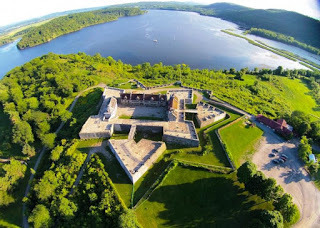 Fort Ticonderoga
Fort Ticonderoga
The Siege
The war included several key sieges. Most were of short duration with one side capitulating or the other breaking off the siege due to external factors such as weather, supply or advancing reinforcements. Fort Stanwix, Savannah, Charleston and Newport are examples. Yet even a short-lived defense of a post could buy precious time for a commander to gather forces, regroup, maneuver to advantage or just get the heck out of Dodge. That is one reason that a commander, when forced to a long investment of a post, or more importantly, forced to storm a post, harshly treats the defenders and any hapless civilians left at the end. Ironically, those occasions where the British treated the defenders harshly merely fed rebel propaganda, which played no insignificant part in the struggle. Not only were the American populace keenly observing things - the entire world was watching. That is material for another post, however.
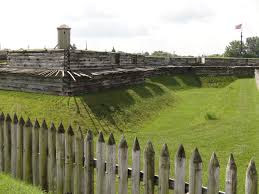 Fort Stanwix
Fort Stanwix
Fort Mifflin
Arguably longest active defense of a post under siege in the war was also one of the least celebrated. We will try to move the needle in the direction of celebration. Fort Mifflin lies on the Delaware River, in today's South Philadelphia, at a place called Mud Island. Construction on the fort began in 1772 to bar the approach to the city. Ironically the original construction was under the famous British engineer officer Captain John Montessor. The fort was completed in 1777 under the direction of American Major General Thomas Mifflin, from whom it draws its name. It protected a line of water obstacles that stretched across the river to sister fort, Fort Mercer, in New Jersey.
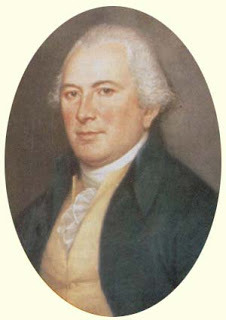 Maj Gen Thomas Mifflin
Maj Gen Thomas Mifflin
finished construction of fort that bears his name
Most Formidable Defenses
A fort covering a sea approach needed more than stout walls and good fields of fire. So Philadelphia built a series of chevaux de frise, placed in "tiers" beneath the waters of the Delaware between Forts Mercer and Mifflin. They were built into wooden-framed boxes, 30 feet square, made from huge timbers lined with pine boards. The engineers sunk these frames into the riverbed. Each box was filled with 20 to 40 tons of stone to anchor in place. Each frame had two or three large timbers tipped with iron spikes set underwater and facing obliquely downstream. These chevaux made for a powerful obstacle that posed a danger to unwitting ships. The string of chevaux had gaps so friendly shipping could pass. The location of these safe passages was a highly guarded secret. Any British ship not impaled on the spikes or caught up in the chain still risked trained fire from the forts themselves.
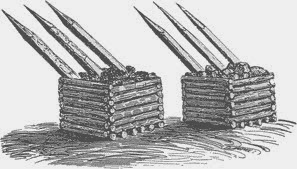 Sketch of chevaux crates filled
Sketch of chevaux crates filled
with stones
A Strategic Position
The British captured Philadelphia in September 1777 by an overland campaign that avoided the fortified Delaware approach. But the British commander in chief, General William Howe now faced the need to open his line of communications to the sea. He needed the protection of the Royal Navy and an open supply line or his position in Philadelphia could become a liability. The British commander realized that their command of the sea was an invaluable advantage over the Americans that must be used to maximum advantage. Howe's brother, Admiral Richard "Black Dick" Howe, commander of the Royal Navy in America, had already begun reducing American defenses down river. But brother Billy could not wait for their arrival. He needed to move overland against Fort Mifflin and save the navy for Fort Mercer on the Jersey side.
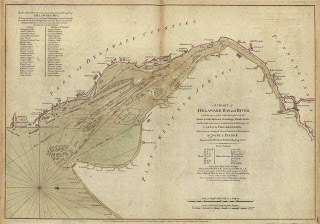 Control of lower Delaware River and bay
Control of lower Delaware River and bay
was crucial to British success
Doughty Defenders
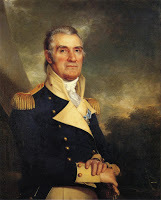 Samuel SmithBut the American commander in chief, General George Washington, also recognized the value of the Delaware. Driven from the vicinity of the capital after his defeat at German town, Washington prepared for a long series of operations aimed at disrupting British plans to solidify their hold on Philadelphia. On 23 September , Washington sent Lieutenant Colonel Samuel Smith of the 4th Maryland Regiment with a detachment of Continentals into the fort on Mud Island on the Delaware River. Readers may recall I profiled this first patriot in an earlier Yankee Doodle Spies post. Smith's initial force numbered 200 soldiers plus Major Robert Ballard of Virginia, Major Simeon Thayer of Rhode Island, and Captain Samuel Treat of the Continental Artillery. Resolved to thwart British efforts at whatever cost, the Continentals went to work preparing the defenses while summoning more troops for the defense. Eventually they would have 400 men, not nearly enough to adequately garrison a fort of Mifflin's size. This was a problem that plagued other forces attempting to hold forts Ticonderoga and Washington. Yet Smith and his men resolved to make the most of the fort.
Samuel SmithBut the American commander in chief, General George Washington, also recognized the value of the Delaware. Driven from the vicinity of the capital after his defeat at German town, Washington prepared for a long series of operations aimed at disrupting British plans to solidify their hold on Philadelphia. On 23 September , Washington sent Lieutenant Colonel Samuel Smith of the 4th Maryland Regiment with a detachment of Continentals into the fort on Mud Island on the Delaware River. Readers may recall I profiled this first patriot in an earlier Yankee Doodle Spies post. Smith's initial force numbered 200 soldiers plus Major Robert Ballard of Virginia, Major Simeon Thayer of Rhode Island, and Captain Samuel Treat of the Continental Artillery. Resolved to thwart British efforts at whatever cost, the Continentals went to work preparing the defenses while summoning more troops for the defense. Eventually they would have 400 men, not nearly enough to adequately garrison a fort of Mifflin's size. This was a problem that plagued other forces attempting to hold forts Ticonderoga and Washington. Yet Smith and his men resolved to make the most of the fort.
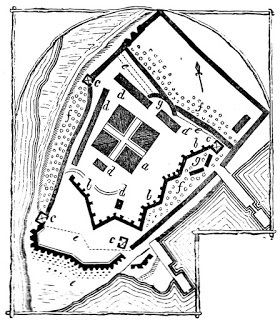 Fort Mifflin plans
Fort Mifflin plans
The British Approach
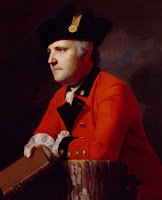 John MontressorGeneral Howe ordered a move on nearby Providence Island on 10 October, 1777. Washington's land forces resisted, but were quickly driven off and soon heavy siege guns were set into battery facing the American fort. Formidible as it was, Fort Mifflin had not been heavily fortified for a threat from Philadelphia. In no small bit of irony, Captain John Montresor, earlier designer and builder Fort Mifflin, planned and built the siege works used against his fort. Things were certainly stacked against the rebels. Soon, heavy balls came crashing into the American positions. The pounding against that side of the fort was horrific, but the American fought back gallantly, inflicting heavy damage on several British ships that tried to force their way up river. The British mounted guns on floats, forming water batteries that edged closer to the beleaguered outpost. American casualties mounted and supplies dwindled over the month of horrific bombardment and deprivation.
John MontressorGeneral Howe ordered a move on nearby Providence Island on 10 October, 1777. Washington's land forces resisted, but were quickly driven off and soon heavy siege guns were set into battery facing the American fort. Formidible as it was, Fort Mifflin had not been heavily fortified for a threat from Philadelphia. In no small bit of irony, Captain John Montresor, earlier designer and builder Fort Mifflin, planned and built the siege works used against his fort. Things were certainly stacked against the rebels. Soon, heavy balls came crashing into the American positions. The pounding against that side of the fort was horrific, but the American fought back gallantly, inflicting heavy damage on several British ships that tried to force their way up river. The British mounted guns on floats, forming water batteries that edged closer to the beleaguered outpost. American casualties mounted and supplies dwindled over the month of horrific bombardment and deprivation.
The Royal Navy Engages
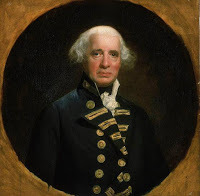 "Black Dick" Howe -
"Black Dick" Howe -
so named for a swarthy complexionBut Billie Howe's brother, "Black Dick", would have the last say. He was finally able to unleash the Royal Navy. On 10 November, a floating battery of twenty-two heavy 24-pound guns closed to within 40 yards of the fort. At point blank range, the British gunners could have their way, big time. This turned out to be the heaviest bombardment of the Revolutionary War. Shot and shell pounded walls and buildings to pieces. Defenders had limbs torn away or crushed. The battle was tilting toward the besiegers but Smith and the defenders were determined to defend the fort. The cold weather was coming early and if they could hold
until the Delaware froze the British supply line might be cut, forcing Howe's army to abandon the recently captured capital. On the British side, word of the catastrophic surrender of Major General John Burgoyne's army at Saratoga put pressure on both Howe brothers. A victory over the stubborn defenders would helped offset the obvious drop in morale. The stakes were high for both sides!
The Pennsylvania navy (yes, they had a navy) came to the aid of the forts guarding the Delaware approaches. Commodore John Hazelwood, with a sizable fleet of galleys, sloops and fire-vessels launched several raids on British positions on shore and constantly harassed British river operations while patrolling the waters around the fort. But British naval strength eventually held sway. Rebel resistance continued. Cold, ill and starving, the garrison, reduced to much less than 200 the original 400-450 men, refused to give up. Under the direction of French Major Francois de Fleury, an engineer of extraordinary energy, the Americans worked each night to repair the damage of the day. Fleury himself was wounded in the battle. A British ship of the line and sloop o' war both ran aground under the pummeling fire from Mifflin's defenders. But British naval superiority virtually guaranteed a bad outcome. Under cover of the murderous fire from the big guns of the floating battery, the British naval vessels closed in and soon British marines were sniping at the fort from high up in the rigging. With almost all their guns knocked out of action, the Americans were running out of options - but not out of gumption.
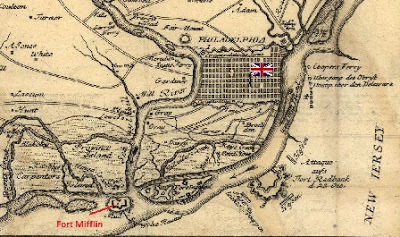 Fort Mifflin aka Mudd Island
Fort Mifflin aka Mudd Island
was the key to the Delaware
The Final British Assault
Clear weather on 15 November gave the British a chance to turn up a final blast of heat. They sent two ships, Vigilant and Fury, with nineteen guns up the back channel to the west of Fort Mifflin. At the same time, three large ships armed with 158 cannon anchored directly offshore of the fort, in the main channel of the Delaware. To the east, three more vessels armed with some 51 guns ensured Mifflin's enfilade from all sides. A trap of smoke, fire and iron.
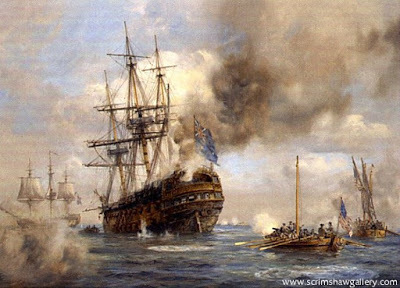 The Royal Navy had to commit
The Royal Navy had to commit
massive resources to subdue the fort
To counter this British juggernaut, the defenders of Fort Mifflin had only ten cannon left. Soon, hundreds of cannon balls began blasting what was left in the fort. The large caliber 18 and 24 pound balls tore through the defenders in another shower of smoke and fire. During the heaviest hour of the bombardment, some 1000 shot were fired into the fort. To add to the defenders' misery, British Marines climbed to the crow’s nest of Vigilant toss grenades at the fort's defenders. The defenders bravely fought on but suffered for it as casualties mounted. They returned fire until all their guns were silenced by the heavier British shot. Lieutenant Colonel Smith was seriously wounded and had to be evacuated. The end was near.
The End
Nightfall found the surviving defenders exhausted, cold and out of ammunition. But not out of options. The new commander of the fort, Major Simeon Thayer decided to evacuate the now indefensible Mifflin. Under the cover of darkness. the garrison rowed their way with muffled oars to Fort Mercer. Forty men volunteered to stay on and set fire to what was left. Their work done, around midnight, they too crossed the Delaware to the safety of New Jersey. But Thayer decided on one last act of resistance. So as the last of Mifflin's valiant defenders rowed to safety they would see it ablaze - but they would see the flag still flying in a final gesture of defiance.
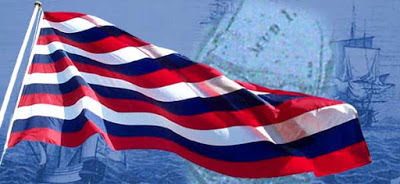 The unusual looking flag that flew over Fort Mifflin during
The unusual looking flag that flew over Fort Mifflin during
the long siege and in a final act of defiance
The Result
During the siege, some 400 American soldiers held off more than two thousand British troops and 250 ships. The Americans suffered over 250 killed and wounded and lost the fort. But the time and resources expended by the Howe brothers to take the fort and control the Delaware enabled Washington to deploy his army to White Marsh and ultimately get to the safety of winter quarters at Valley Forge where a new American army was born.
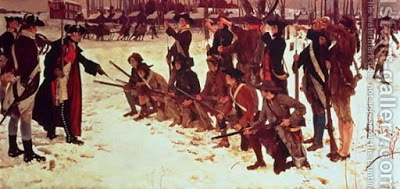 A new American army would emerge from
A new American army would emerge from
the hard winter at Valley Forge
Aftermath
Fort Mifflin was rebuilt after the war and used for many years as a US base, providing (of course) one of the strategic harbor defenses for Philadelphia. Later it became a historic site. But of the original Fort Mifflin, only the white stone walls of the fort still survive today. The pockmarks in these stone walls give evidence of the intensity of the British bombardment of 1777. Local residents know this siege and massive bombardment as the Battle of Mud Island. But this once critical piece in the defense of the Delaware and Philadelphia never again saw military action.
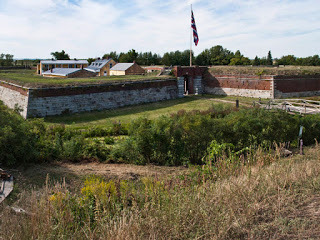
Over eight years of struggle, the American Revolutionary War lurched from guerrilla war to limited war, and occasionally a war of maneuver. But the exigencies of 18th century warfare in an expansive area of operations characterized by rough terrain, dense forests, and uncooperative rivers made it at almost all times, a war of posts. A war of posts is often like a chess match, with deliberately placed defensive positions aimed at securing supply lines, blocking an enemy advance and securing critical regions. Think of the game Risk, but with real men and sweat and toil, not little wooden or plastic markers. The struggle for North America had several key engagements involving fixed fortifications. In many ways these defined the war: West Point and Ticonderoga come to mind. But there were many with temporary or hastily built fortifications. These proved crucial as well. Fort Moultrie, Stony Point and Yorktown provide examples.
 Fort Ticonderoga
Fort TiconderogaThe Siege
The war included several key sieges. Most were of short duration with one side capitulating or the other breaking off the siege due to external factors such as weather, supply or advancing reinforcements. Fort Stanwix, Savannah, Charleston and Newport are examples. Yet even a short-lived defense of a post could buy precious time for a commander to gather forces, regroup, maneuver to advantage or just get the heck out of Dodge. That is one reason that a commander, when forced to a long investment of a post, or more importantly, forced to storm a post, harshly treats the defenders and any hapless civilians left at the end. Ironically, those occasions where the British treated the defenders harshly merely fed rebel propaganda, which played no insignificant part in the struggle. Not only were the American populace keenly observing things - the entire world was watching. That is material for another post, however.
 Fort Stanwix
Fort StanwixFort Mifflin
Arguably longest active defense of a post under siege in the war was also one of the least celebrated. We will try to move the needle in the direction of celebration. Fort Mifflin lies on the Delaware River, in today's South Philadelphia, at a place called Mud Island. Construction on the fort began in 1772 to bar the approach to the city. Ironically the original construction was under the famous British engineer officer Captain John Montessor. The fort was completed in 1777 under the direction of American Major General Thomas Mifflin, from whom it draws its name. It protected a line of water obstacles that stretched across the river to sister fort, Fort Mercer, in New Jersey.
 Maj Gen Thomas Mifflin
Maj Gen Thomas Mifflinfinished construction of fort that bears his name
Most Formidable Defenses
A fort covering a sea approach needed more than stout walls and good fields of fire. So Philadelphia built a series of chevaux de frise, placed in "tiers" beneath the waters of the Delaware between Forts Mercer and Mifflin. They were built into wooden-framed boxes, 30 feet square, made from huge timbers lined with pine boards. The engineers sunk these frames into the riverbed. Each box was filled with 20 to 40 tons of stone to anchor in place. Each frame had two or three large timbers tipped with iron spikes set underwater and facing obliquely downstream. These chevaux made for a powerful obstacle that posed a danger to unwitting ships. The string of chevaux had gaps so friendly shipping could pass. The location of these safe passages was a highly guarded secret. Any British ship not impaled on the spikes or caught up in the chain still risked trained fire from the forts themselves.
 Sketch of chevaux crates filled
Sketch of chevaux crates filledwith stones
A Strategic Position
The British captured Philadelphia in September 1777 by an overland campaign that avoided the fortified Delaware approach. But the British commander in chief, General William Howe now faced the need to open his line of communications to the sea. He needed the protection of the Royal Navy and an open supply line or his position in Philadelphia could become a liability. The British commander realized that their command of the sea was an invaluable advantage over the Americans that must be used to maximum advantage. Howe's brother, Admiral Richard "Black Dick" Howe, commander of the Royal Navy in America, had already begun reducing American defenses down river. But brother Billy could not wait for their arrival. He needed to move overland against Fort Mifflin and save the navy for Fort Mercer on the Jersey side.
 Control of lower Delaware River and bay
Control of lower Delaware River and baywas crucial to British success
Doughty Defenders
 Samuel SmithBut the American commander in chief, General George Washington, also recognized the value of the Delaware. Driven from the vicinity of the capital after his defeat at German town, Washington prepared for a long series of operations aimed at disrupting British plans to solidify their hold on Philadelphia. On 23 September , Washington sent Lieutenant Colonel Samuel Smith of the 4th Maryland Regiment with a detachment of Continentals into the fort on Mud Island on the Delaware River. Readers may recall I profiled this first patriot in an earlier Yankee Doodle Spies post. Smith's initial force numbered 200 soldiers plus Major Robert Ballard of Virginia, Major Simeon Thayer of Rhode Island, and Captain Samuel Treat of the Continental Artillery. Resolved to thwart British efforts at whatever cost, the Continentals went to work preparing the defenses while summoning more troops for the defense. Eventually they would have 400 men, not nearly enough to adequately garrison a fort of Mifflin's size. This was a problem that plagued other forces attempting to hold forts Ticonderoga and Washington. Yet Smith and his men resolved to make the most of the fort.
Samuel SmithBut the American commander in chief, General George Washington, also recognized the value of the Delaware. Driven from the vicinity of the capital after his defeat at German town, Washington prepared for a long series of operations aimed at disrupting British plans to solidify their hold on Philadelphia. On 23 September , Washington sent Lieutenant Colonel Samuel Smith of the 4th Maryland Regiment with a detachment of Continentals into the fort on Mud Island on the Delaware River. Readers may recall I profiled this first patriot in an earlier Yankee Doodle Spies post. Smith's initial force numbered 200 soldiers plus Major Robert Ballard of Virginia, Major Simeon Thayer of Rhode Island, and Captain Samuel Treat of the Continental Artillery. Resolved to thwart British efforts at whatever cost, the Continentals went to work preparing the defenses while summoning more troops for the defense. Eventually they would have 400 men, not nearly enough to adequately garrison a fort of Mifflin's size. This was a problem that plagued other forces attempting to hold forts Ticonderoga and Washington. Yet Smith and his men resolved to make the most of the fort. Fort Mifflin plans
Fort Mifflin plansThe British Approach
 John MontressorGeneral Howe ordered a move on nearby Providence Island on 10 October, 1777. Washington's land forces resisted, but were quickly driven off and soon heavy siege guns were set into battery facing the American fort. Formidible as it was, Fort Mifflin had not been heavily fortified for a threat from Philadelphia. In no small bit of irony, Captain John Montresor, earlier designer and builder Fort Mifflin, planned and built the siege works used against his fort. Things were certainly stacked against the rebels. Soon, heavy balls came crashing into the American positions. The pounding against that side of the fort was horrific, but the American fought back gallantly, inflicting heavy damage on several British ships that tried to force their way up river. The British mounted guns on floats, forming water batteries that edged closer to the beleaguered outpost. American casualties mounted and supplies dwindled over the month of horrific bombardment and deprivation.
John MontressorGeneral Howe ordered a move on nearby Providence Island on 10 October, 1777. Washington's land forces resisted, but were quickly driven off and soon heavy siege guns were set into battery facing the American fort. Formidible as it was, Fort Mifflin had not been heavily fortified for a threat from Philadelphia. In no small bit of irony, Captain John Montresor, earlier designer and builder Fort Mifflin, planned and built the siege works used against his fort. Things were certainly stacked against the rebels. Soon, heavy balls came crashing into the American positions. The pounding against that side of the fort was horrific, but the American fought back gallantly, inflicting heavy damage on several British ships that tried to force their way up river. The British mounted guns on floats, forming water batteries that edged closer to the beleaguered outpost. American casualties mounted and supplies dwindled over the month of horrific bombardment and deprivation.The Royal Navy Engages
 "Black Dick" Howe -
"Black Dick" Howe -so named for a swarthy complexionBut Billie Howe's brother, "Black Dick", would have the last say. He was finally able to unleash the Royal Navy. On 10 November, a floating battery of twenty-two heavy 24-pound guns closed to within 40 yards of the fort. At point blank range, the British gunners could have their way, big time. This turned out to be the heaviest bombardment of the Revolutionary War. Shot and shell pounded walls and buildings to pieces. Defenders had limbs torn away or crushed. The battle was tilting toward the besiegers but Smith and the defenders were determined to defend the fort. The cold weather was coming early and if they could hold
until the Delaware froze the British supply line might be cut, forcing Howe's army to abandon the recently captured capital. On the British side, word of the catastrophic surrender of Major General John Burgoyne's army at Saratoga put pressure on both Howe brothers. A victory over the stubborn defenders would helped offset the obvious drop in morale. The stakes were high for both sides!
The Pennsylvania navy (yes, they had a navy) came to the aid of the forts guarding the Delaware approaches. Commodore John Hazelwood, with a sizable fleet of galleys, sloops and fire-vessels launched several raids on British positions on shore and constantly harassed British river operations while patrolling the waters around the fort. But British naval strength eventually held sway. Rebel resistance continued. Cold, ill and starving, the garrison, reduced to much less than 200 the original 400-450 men, refused to give up. Under the direction of French Major Francois de Fleury, an engineer of extraordinary energy, the Americans worked each night to repair the damage of the day. Fleury himself was wounded in the battle. A British ship of the line and sloop o' war both ran aground under the pummeling fire from Mifflin's defenders. But British naval superiority virtually guaranteed a bad outcome. Under cover of the murderous fire from the big guns of the floating battery, the British naval vessels closed in and soon British marines were sniping at the fort from high up in the rigging. With almost all their guns knocked out of action, the Americans were running out of options - but not out of gumption.
 Fort Mifflin aka Mudd Island
Fort Mifflin aka Mudd Islandwas the key to the Delaware
The Final British Assault
Clear weather on 15 November gave the British a chance to turn up a final blast of heat. They sent two ships, Vigilant and Fury, with nineteen guns up the back channel to the west of Fort Mifflin. At the same time, three large ships armed with 158 cannon anchored directly offshore of the fort, in the main channel of the Delaware. To the east, three more vessels armed with some 51 guns ensured Mifflin's enfilade from all sides. A trap of smoke, fire and iron.
 The Royal Navy had to commit
The Royal Navy had to commitmassive resources to subdue the fort
To counter this British juggernaut, the defenders of Fort Mifflin had only ten cannon left. Soon, hundreds of cannon balls began blasting what was left in the fort. The large caliber 18 and 24 pound balls tore through the defenders in another shower of smoke and fire. During the heaviest hour of the bombardment, some 1000 shot were fired into the fort. To add to the defenders' misery, British Marines climbed to the crow’s nest of Vigilant toss grenades at the fort's defenders. The defenders bravely fought on but suffered for it as casualties mounted. They returned fire until all their guns were silenced by the heavier British shot. Lieutenant Colonel Smith was seriously wounded and had to be evacuated. The end was near.
The End
Nightfall found the surviving defenders exhausted, cold and out of ammunition. But not out of options. The new commander of the fort, Major Simeon Thayer decided to evacuate the now indefensible Mifflin. Under the cover of darkness. the garrison rowed their way with muffled oars to Fort Mercer. Forty men volunteered to stay on and set fire to what was left. Their work done, around midnight, they too crossed the Delaware to the safety of New Jersey. But Thayer decided on one last act of resistance. So as the last of Mifflin's valiant defenders rowed to safety they would see it ablaze - but they would see the flag still flying in a final gesture of defiance.
 The unusual looking flag that flew over Fort Mifflin during
The unusual looking flag that flew over Fort Mifflin duringthe long siege and in a final act of defiance
The Result
During the siege, some 400 American soldiers held off more than two thousand British troops and 250 ships. The Americans suffered over 250 killed and wounded and lost the fort. But the time and resources expended by the Howe brothers to take the fort and control the Delaware enabled Washington to deploy his army to White Marsh and ultimately get to the safety of winter quarters at Valley Forge where a new American army was born.
 A new American army would emerge from
A new American army would emerge fromthe hard winter at Valley Forge
Aftermath
Fort Mifflin was rebuilt after the war and used for many years as a US base, providing (of course) one of the strategic harbor defenses for Philadelphia. Later it became a historic site. But of the original Fort Mifflin, only the white stone walls of the fort still survive today. The pockmarks in these stone walls give evidence of the intensity of the British bombardment of 1777. Local residents know this siege and massive bombardment as the Battle of Mud Island. But this once critical piece in the defense of the Delaware and Philadelphia never again saw military action.

Published on September 29, 2018 12:08
August 5, 2018
People: A Yankee Doodle Rake
Beauing, belling, dancing, drinking,Breaking windows, cursing, sinkingEvery raking, never thinking,Live the Rakes of Mallow,
Spending faster than it comes,Beating waiter's bailiffs, duns,Bacchus' true begotten sons,Live the Rakes of Mallow.
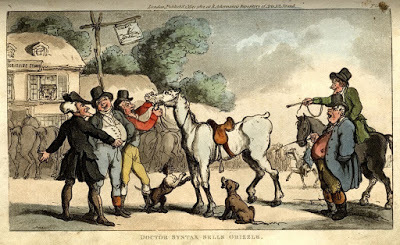
And so begin the lyrics the mid 18th century song that remains in today's culture as an international classic, The Rakes of Mallow... A song about the rakes from the farming town of Mallow, some 20 miles north of the city of Cork. What is a rake? Although Mallow is a farming town, we are not dealing with the instrument used for gardening. The other rake is an archaic term for a carousing, gambling, drinking and womanizing sort. The kind of person both celebrated and berated by Georgian England... Which brings to the rake of this story - the complex and never uninteresting George Hanger...
The Rake at Dawn
George Hanger was born near Berkshire, England around 1751. His father was Gabriel, 3rd Baron Coleraine, an Irish peerage. As the third son of an upper class noble, it was all but preordained that he was bound for the military. Hanger was educated at Eton and then spent a year at the University of Goettingen in Hannover, Germany. A bright student, Hanger cut a "rakish" figure and favored the proverbial wine, women and gambling - not necessarily in that order. He allegedly fought three duels by time he was age 20 and was reputed a crack shot. While in Germany, Hanger observed the famed Prussian Army of Frederick the Great on maneuver and determined then and there to pursue a military career. In January 1771, he was appointed an ensign in the 1st Foot Guards, a posh regiment of the household troops. Hanger served well but resigned after he was passed over for promotion just four years later. Already, inklings of his lifestyle began to swirl.
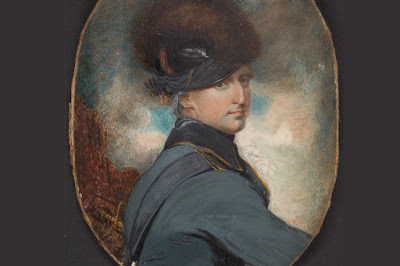 George Hanger
George HangerSoldier for Hire
Hanger's German contacts served him well, however, and he soon received a captain's commission in the Feldjager Korps of the forces of the Landgraf (Elector )of Hesse-Kassel, another elite unit. I think we know where this is going... It was as part of this band of young teutonic aristocrats that Hanger sailed for America when the Landgraf "rented" his troops to King George III. Leaving Portsmouth in March 1776, young Hanger would arrive in time for some of the most "fun" episodes for crown forces during the entire eight year struggle. He played a role in the juggernaut campaigns that swept the rebels from New York and the Jerseys in 1776. And in the less glamorous but no less savage escapades of 1777. His performance was such that he assumed command of an elite Hessian Jaeger (light infantry) company drawn from all the Hessian regiments of the army. By all accounts, Hanger distinguished himself in the months that followed. His unit did more than its share of screening, patrolling and small scale fighting in the area around the Kingsbridge, Spuyten Duyvil and Westchester. Around this time he learned that his estate in Britain had gone into foreclosure, and through a series of misfortunes, he was worse than broke. Our young hero had become a self-styled "soldier of fortune."
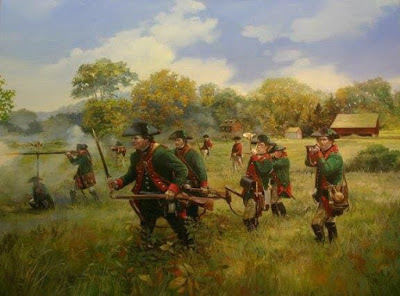 Hanger became a master of light infantry
Hanger became a master of light infantryAn Unlikely Spy
When the British occupation of Newport, Rhode Island ended in 1779, Hanger was tapped by the British commander in chief General Henry Clinton to go on a daring reconnaissance mission to ascertain if the American occupiers had left its defenses ripe for reconquest. He sailed the 150 miles north from the mouth of New York harbor on a frigate and led a twelve man long boat into dangerous waters on a daring night raid. He captured a prisoner and returned to New York with him. Hanger was later castigated in the American papers when the prisoner suddenly took ill and died.
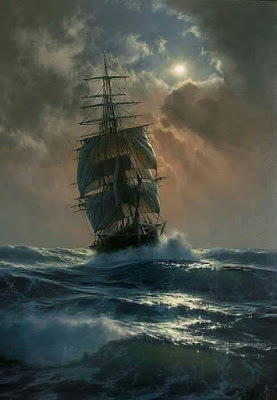 An unlikely Hanger sails on a secret mission
An unlikely Hanger sails on a secret missionto Rhode Island: espionage
Moving South
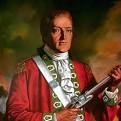 Patrick Ferguson
Patrick Ferguson- a badassLater, Hanger took command of a series of mixed rifle/musket units and was seconded to the famed "counter guerrilla" Major Patrick Ferguson, one of the badass British officers of the war whose demise at King's Mountain would herald the beginning of the end in the south. But I digress. With Ferguson, Hanger sailed to the Carolinas under General Henry Clinton in the spring of 1780 - the opening of the "southern strategy." After a short stint as Clinton's aide de camp and then inspector of militia under Ferguson, the ever-mobile Hanger managed a transfer to the Banastre Tarleton's British Legion. The two hard drinking, rough and tumble aristocrats hit it off and Tarleton made Hanger his deputy. Hanger had joined the green jacketed band of Loyalist regulars that would become notorious under Tarleton.
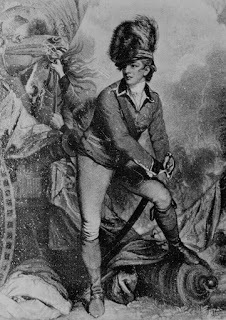 A likely duo: Infamous Banastre Tarleton
A likely duo: Infamous Banastre Tarleton became Hanger's mentor and commander
The Legion
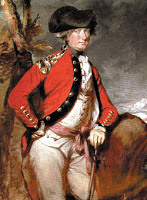 Lord Charles CornwallisThe Legion led Major General Charles Cornwallis's invasion of North Carolina. When Tarleton was felled by yellow fever, Hanger took command. Although an accomplished infantry fighter and dependable deputy, Hanger would run into difficulty handling the cavalry, the important strike force of Tarleton's Legion. He allowed himself to be ambushed at Wahab Plantation on 21 September 1780, where a partisan force under American Colonel William Davie struck in the early evening. Surprised and overwhelmed, Hanger lost 12 killed 47 wounded and almost 100 invaluable horses captured. Tasked with leading the British advance against Charlotte less than a week later, he mucked things up once more. This time, he let his horsemen get separated from their supporting infantry. Once more, Davie took the measure of him when Hanger's cavalry rode recklessly into the town unsupported. Hanger led several charges against Davie's American riflemen, defending behind a wall. Hanger's men began falling to the well aimed fire. Cornwallis himself had to take charge to steady the situation. Hanger was badly wounded during the fray and then contracted yellow fever. Sick and wounded, he was sent to the Bahamas (of all places) to recover.
Lord Charles CornwallisThe Legion led Major General Charles Cornwallis's invasion of North Carolina. When Tarleton was felled by yellow fever, Hanger took command. Although an accomplished infantry fighter and dependable deputy, Hanger would run into difficulty handling the cavalry, the important strike force of Tarleton's Legion. He allowed himself to be ambushed at Wahab Plantation on 21 September 1780, where a partisan force under American Colonel William Davie struck in the early evening. Surprised and overwhelmed, Hanger lost 12 killed 47 wounded and almost 100 invaluable horses captured. Tasked with leading the British advance against Charlotte less than a week later, he mucked things up once more. This time, he let his horsemen get separated from their supporting infantry. Once more, Davie took the measure of him when Hanger's cavalry rode recklessly into the town unsupported. Hanger led several charges against Davie's American riflemen, defending behind a wall. Hanger's men began falling to the well aimed fire. Cornwallis himself had to take charge to steady the situation. Hanger was badly wounded during the fray and then contracted yellow fever. Sick and wounded, he was sent to the Bahamas (of all places) to recover.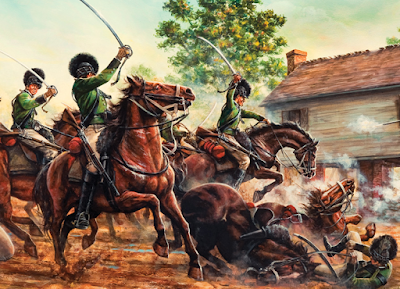 Hanger led the Legion's cavalry to savage fighting and defeat
Hanger led the Legion's cavalry to savage fighting and defeatat Charlotte
Dead Ender?
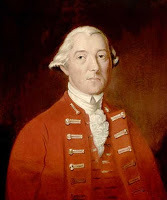 Guy CarletonWhen he recovered sufficiently, Hanger returned to New York in the summer of 1781 and assumed garrison duties. As the key to Britain's control over North America, New York was the center of gravity and Hanger was back in the mix. He was also back in the city most replete with barts, brothels and bedrooms for him to enjoy when not drilling troops or patrolling the outskirts of the city. One would think our young rake had the best of both worlds during this period. Ever the soldier, he sailed with General Clinton's relief force aimed at saving Cornwallis's trapped army at Yorktown. On learning of the surrender, he returned to the city with the rest of the fleet. As the peace negotiations settled on terms, Hanger played another role: resettling members of the Legion. In that effort he made a trip to Halifax, Nova Scotia, to find land and quarters for the loyalists who did not opt for England. Mission accomplished, he returned to New York. One has to think of George as a proverbial dead-ender. He remained with one of the last British units to evacuate the city, sailing with the last British commander and governor in North America, General Guy Carleton.
Guy CarletonWhen he recovered sufficiently, Hanger returned to New York in the summer of 1781 and assumed garrison duties. As the key to Britain's control over North America, New York was the center of gravity and Hanger was back in the mix. He was also back in the city most replete with barts, brothels and bedrooms for him to enjoy when not drilling troops or patrolling the outskirts of the city. One would think our young rake had the best of both worlds during this period. Ever the soldier, he sailed with General Clinton's relief force aimed at saving Cornwallis's trapped army at Yorktown. On learning of the surrender, he returned to the city with the rest of the fleet. As the peace negotiations settled on terms, Hanger played another role: resettling members of the Legion. In that effort he made a trip to Halifax, Nova Scotia, to find land and quarters for the loyalists who did not opt for England. Mission accomplished, he returned to New York. One has to think of George as a proverbial dead-ender. He remained with one of the last British units to evacuate the city, sailing with the last British commander and governor in North America, General Guy Carleton.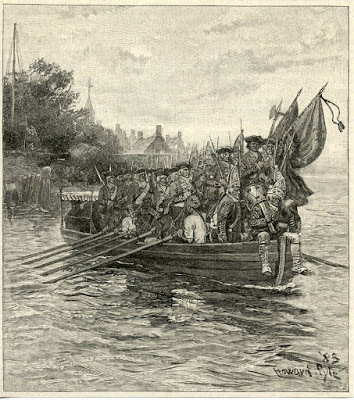 Hanger in a "Forrest Gump" like move, manages to
Hanger in a "Forrest Gump" like move, manages towitness the American Revolution's climax
The Bad Boy of Georgian England
Once home, Hanger returned to the life of flamboyant party-boy. He became a party-companion of that other rake, the Prince of Wales, who later became King George IV. The prince was amused by Hanger's rakish ways. Hanger seems to have become famous for being famous, as they say - the subject of much satire and ridicule in the equivalent of today's tabloids. His fast living landed him in debtor's prison where he spent two years (1798-1800). He turned to writing while in prison and there produced his memoirs.
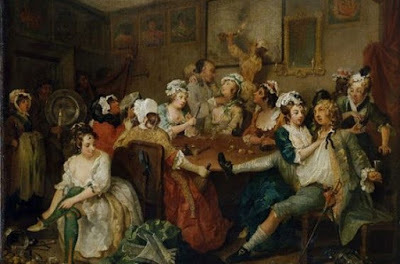 Hanger and his buddy the Prince of Wales
Hanger and his buddy the Prince of Walesattended many a party
When he got out he became a coal merchant (at which he was quite successful) but continued his addiction to gambling and carousing around London. Throughout, Hanger flaunted contemporary mores, cavorting openly with women of all stripes, keeping a strange collection of dogs, cats and monkeys, and generally thumbing it at the upper crust and middle class. One of his celebrated exploits was arranging a cross country race between a flock of turkeys and flock of geese!
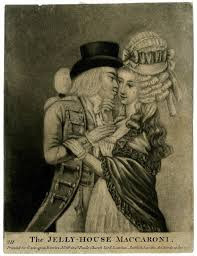 Cartoon satire of Hanger
Cartoon satire of HangerAt the same, he learned to capitalize on some of his strong suits as a pamphleteer - who were sort of the bloggers of their day. Reinventing himself as a subject matter expert, he published pamphlets on military subjects,gambling, hunting, and shooting. Hanger engaged in public disputes over military policy during the Napoleonic wars. He wrote absurd advice columns on all sorts of things but most famously on the fairer sex. His escapades and opinions were followed closely by the media of his day. In 1814 he was offered the barony of Coleraine but he turned it down to continue his "celebrated" lifestyle in London.
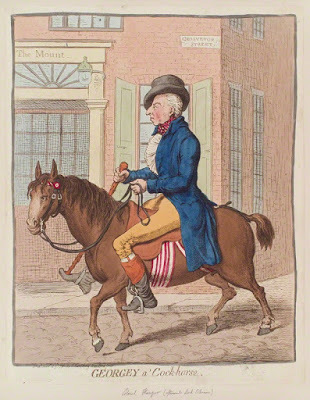 Cartoon satire of Hanger
Cartoon satire of HangerThe Legacy
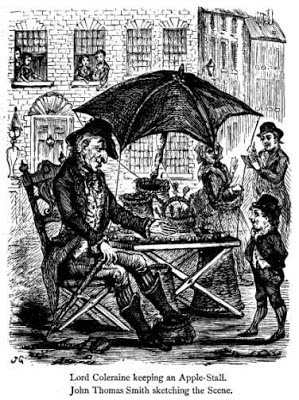 Cartoon satire of Hanger
Cartoon satire of HangerDespite the hard living, Hanger continued his lifestyle as rake about town, military "expert" and celebrated eccentric until he died in London on 31 March, 1824. He left a second wife, possibly his housekeeper, and their son, who was denied his father's peership. George Hanger was clearly one of the more complex men of his times and certainly one of the most interesting, if not amusing.
Eventually his notoriety caught up with him. The king parted ways. High society shunned him. And the press mocked him. Yet in many ways, he was emblematic of his class and times: a curious mix of breeding, talent, courage, rapacity and culture. Pity he did not settle in America...
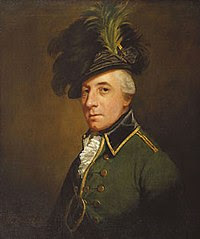 George Hanger, 4th Baron Coleraine?
George Hanger, 4th Baron Coleraine?
Published on August 05, 2018 07:46
June 30, 2018
Things: The Spy of Massachusetts
In my last blog post I discussed the origin of the term, "Spy" and hinted at its use as a naming rubric for 18th century newspapers. Now a (slightly) deeper dive into the subject of newspapers of the American Revolution.
A Literate FrontierBy the mid-1760s, there were 24 weekly newspapers in the 12 colonies, and satirical attacks on government became common practice. Weekly newspapers in major cities and towns were strongholds of patriotism (although there were a few Loyalist papers).
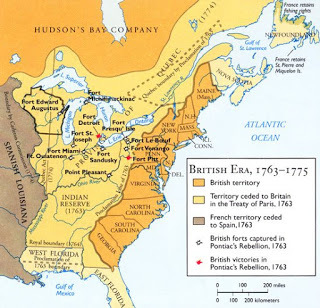 Twelve of the British colonies had 24 newspapers
Twelve of the British colonies had 24 newspapers Spy as a NewspaperSo we can see that the idea of using the name “Spy” for a newspaper was consistent with the origin of the word and its more general use. A paper’s staff and contributors observe, ask about, watch and follow closely. At least that is the hope of the public who rely on their objectivity and sense of fairness. For, as American society became more literate, the power of the press grew.
Turbulent Times
The turbulent years between 1775 and 1783 were a time of great trial and disturbance among newspapers. Interruption, suppression, and lack of support checked their growth substantially. Although there were forty-three newspapers in the United States when the Treaty of Paris was signed in 1783, compared with thirty-seven at the time of the battle of Lexington in 1775, barely a dozen published on a continuing basis during that period. Curiously, not one newspaper in the larger coastal cities - Boston, New York, and Philadelphia, published uninterrupted through the duration of the war.
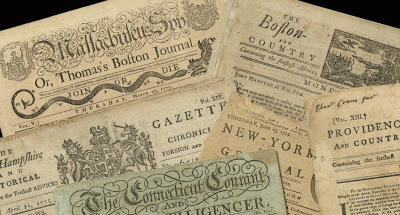 Voices of RebellionObstacles
Voices of RebellionObstaclesThe nature of the rebellion caused some of this. When the colonial forces were in possession, Loyalist papers were suppressed. Conversely, during British occupation, patriot papers dispersed, or were discontinued, or they became Loyalist, until the patriots once more ascended. In result, some papers from the cities along the coast moved inland, where they could continue to publish. Exigencies of war brought logistical problems such as shortages of paper, ink, etc. This brought about poor quality papers or skipped issues to save resources.
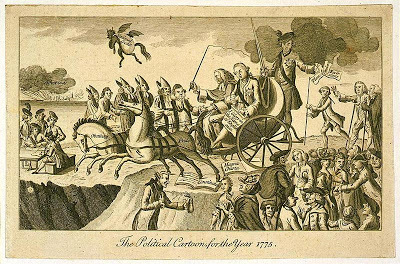 Papers often ran political cartoons and characitures
Papers often ran political cartoons and characituresthat bordered on the absurd
The Massachusetts Spy
Let’s turn to the paper that was the epitome of the kind of “Spy” we are talking about. Isaiah Thomas's Massachusetts Spy, published in Boston and Worcester, was constantly on the verge of being suppressed, from the time of its establishment in 1770 to 1776 and during the American Revolution. In 1771-73 the Spy featured the essays of several anonymous political commentators who called themselves "Centinel," "Mucius Scaevola" and "Leonidas." They spoke in the same terms about similar issues, kept patriot issues on the front page, and responded to attacks by pro-government papers. Rhetorical combat was a patriot tactic that explained the issues of the day and fostered patriotism short of outright rebellion. The columnists spoke to the colonists as an independent people tied to Britain only by voluntary legal compact. The Spy soon carried its radicalism to a logical conclusion. Later, when articles from the Spy were reprinted in other papers, the country as a whole was made ready for Tom Paine's critical patriotic statement: Common Sense in 1776.
 A critical voice in its heyday
A critical voice in its heydayWho was Isaiah Thomas?
We are not talking about a legendary NBA player but a legendary newspaperman. Our Isaiah Thomas was born in Boston, Massachusetts and apprenticed in July 1756 to one Zechariah Fowle, a Boston printer, with whom he formed a partnership in 1770. This resulted in the publication of the Massachusetts Spy. The partnership broke up after a few months, but Thomas continued publication alone. He had a motto for his paper: “Open to all parties, but influenced by none.” Sort of the “Fair & Balanced” of its day. The Spy initially came out three times a week but under Thomas’s sole ownership it became a semi-weekly, and then in 1771, a weekly. The Spy championed the Whig cause early on, resulting in the British government's attempt to suppress it. Massachusetts’s last Royal governor, Thomas Hutchinson, ordered the attorney general to prosecute Thomas, but the grand jury failed to find cause for indictment.
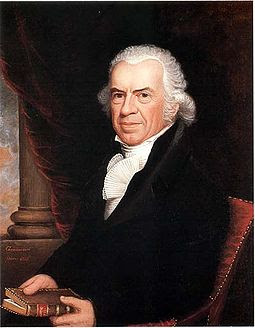 Isaiah Thomas holds an important place in America's
Isaiah Thomas holds an important place in America'spublishing pantheon
More Flash than Bang?
The general spirit of the time produced an abundance of mottoes, editorials, letters, and poems. In the beginning of the struggle both editorials and communications urged united resistance to oppression, praised patriotism, and denounced tyranny. Over time, these patriotic urgings became more vigorous, and in many ways led popular sentiment. Later, the idea of independence took form, and theories of government were discussed. Unfortunately (or fortunately) too often zeal for the cause over rode any semblance of journalistic standards resulting often in exaggerated or even false reporting.
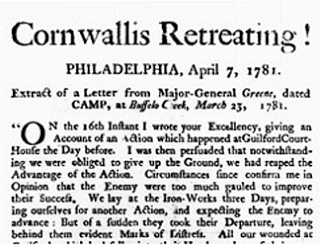
A Struggle of IdeasDespite their shortcomings, the newspapers of the Revolution were an effective force working towards the unification of sentiment, the awakening of a consciousness of a common purpose, interest, and a shared vision of the future among the separate colonies, and of a determination to see the war through to a successful conclusion. They were often more single-minded than the people themselves, and they bore no small share of the burden of arousing and supporting the often discouraged and indifferent public spirit. In this sense they were highly successful in helping shepherd the thirteen hapless colonies in a long and impossible struggle that resulted in an improbable victory.
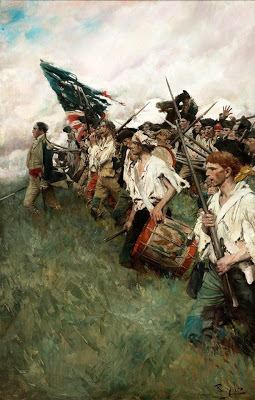 The struggle of ideas led to and buttressed the
The struggle of ideas led to and buttressed thestruggle for independence
Published on June 30, 2018 13:23



